

"I thought this was a home. It was a superstition. What is a home without a child?"
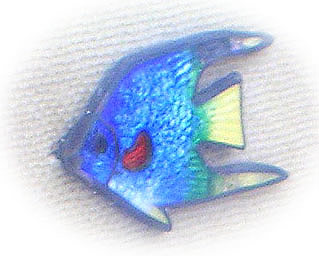 Angel-fish pin given by Mark Twain to Louise Paine. Photo courtesy of Heather Morgan, Mark Twain Library, Redding, CT |
_____
In 1907, at the age of seventy-two, lonely and widowed, Samuel Clemens began "collecting" surrogate granddaughters -- young girls between the ages of ten and sixteen. Some of the girls were those he met aboard ships that carried him back and forth to England or on his travels to the island of Bermuda. Clemens maintained correspondences with the girls -- most were from prominent and wealthy families who traveled in the same social circles with Clemens. They and their parents often visited him in his homes in New York.
In 1906 Clemens had purchased 248 acres in Redding, Connecticut and with proceeds obtained from publishing portions of his autobiography in the North American Review between September 1906 through December 1907, he began construction of a large two-story country home. He originally intended to call the home "Autobiography House." The idea later occurred to him to dedicate the home to his surrogate granddaughters. In 1908 Clemens had begun calling his surrogate granddaughters "angel-fish" after the brilliant species of fish he saw on a visit to Bermuda. He nicknamed his group of girls the "Aquarium Club" and presented members with angel-fish pins. (At least one such pin survives and is currently owned by the Mark Twain Library in Redding, Connecticut.)
In autobiographical dictation of 12 February 1908 Clemens explained his attachment to his collection of girls:
I suppose we are all collectors... As for me, I collect pets: young girls -- girls from ten to sixteen years old; girls who are pretty and sweet and naive and innocent -- dear young creatures to whom life is a perfect joy and to whom it has brought no wounds, no bitterness, and few tears (Cooley, p. xvii).
On 17 April 1908 he elaborated:
After my wife's death, June 5, 1904, I experienced a long period of unrest and loneliness. Clara and Jean were busy with their studies and their labors and I was washing about on a forlorn sea of banquets and speechmaking in high and holy causes... I had reached the grandpapa stage of life; and what I lacked and what I needed was grandchildren. (Cooley, p. xx).
Isabel Lyon, Clemens's secretary, often helped chaperone the young women and facilitated their visits. After accompanying Clemens to Bermuda in April 1908 she recorded in her journal:
He has his aquarium of little girls and they are all angelfish, while he wears a flying fish scarf pin, though he says he is a shad. Off he goes with a flash when he sees a new pair of slim little legs appear and if the little girl wears butterfly bows of ribbon on the back of her head then his delirium is complete. (Hoffmann, p. 104)
In his autobiographical dictation for 17 April 1908, Clemens listed the names of his angel-fish: Dorothy Butes, Frances Nunnally, Dorothy Quick, Margaret Blackmer, Hellen Martin, Jean Spurr, Loraine Allen, Helen Allen, Dorothy Sturgis.
All the ten school-girls in the above list are my angel-fishes, and constitute my Club, whose name is "The Aquarium" ... The Bermudian angel-fish, with its splendid blue decorations, is easily the most beautiful fish that swims ... The club's badge is the angel-fish's splendors reproduced in enamels and mounted for service as a lapel pin -- at least that is where the girls wear it. I get these little pins in Bermuda; they are made in Norway (Cooley, p. 140).
Regarding his plans for the new home he was building in Redding, Connecticut, Clemens dictated:
The billiard-room will have the legend "The Aquarium" over its door ... I have good photographs of all my fishes, and these will be framed and hung around the walls. There is an angel-fish bedroom -- double-bedded -- and I will expect to have a fish and her mother in it as often as Providence will permit (Cooley, p. 141).
By the time Clemens moved into the Redding, Connecticut home on June 18, 1908, he had decided to call the house "Innocence at Home" in honor of his young female acquaintances who he wished to host in an unending series of visits. By the summer of 1908, Clemens had drafted a sort of official constitution, rules and regulations for his "Aquarium." And he added the names of Dorothy Harvey, Louise Paine and Marjorie Breckenridge to the list. Also added to the list was the name Margaret Illington, a young woman in her late twenties and wife of Dan Frohman who was thirty years older than Illington. Dan Frohman was listed as "Legal Staff" for the group.
In September 1908, Clemens's daughter Clara returned from a European singing tour. Clara was evidently not impressed with her father's "club" for young girls. Shortly after her return home, the name of the Redding home was changed to "Stormfield." Biographer John Cooley has observed that soon after Clara Clemens returned, the household stopped saving letters received from the "angel-fish." Clara Clemens objected to her father's relationship, however innocent, with teenage girls.
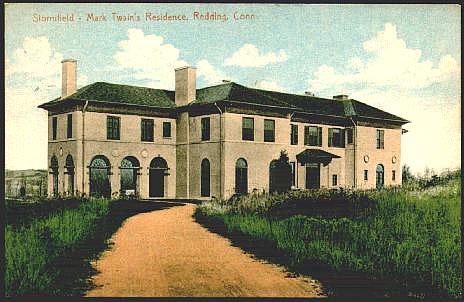
The Clemens
home in Redding, Connecticut was known as "Innocence at Home" in honor
of the angelfish.
It was later renamed "Stormfield."
_____
It should be noted Mark Twain's "Aquarium Club" was not his first organization of female correspondents. Prior to 1902 he had formed "The Juggernaut Club" which consisted of female members -- some of whom he never met. Their task was to write him letters on subjects likely to be of mutual interest to which he would respond. Identities of members of "The Juggernaut Club" have not been fully established other than Helene Picard, who has often been misidentified by biographers as an "angel-fish." Information on the Juggernaut Club and Clemens's letters to Picard are online at "Mark Twain's Juggernaut Club Correspondence - The Helene Picard Letters."
In addition to Clemens's own list of angel-fish, biographers have identified other young women with whom Clemens spent time and corresponded. Gertrude Natkin exhibited a school-girl crush on Clemens until he distanced himself from her. Nineteen-year-old Mary "Paddy" Madden, too old to be considered for angel-fish membership, accompanied Clemens on a five-day trip to Bermuda. Margery Clinton, in her twenties, was referred to as "the plumber" of Stormfield. In 1909 Clemens composed a valentine for a young woman named Ethel Sloan who he met in Bermuda. Clemens also maintained correspondence with other young women and entertained them in his home -- among them was actress Billie Burke who he once jokingly considered for membership in his Aquarium Club. Other young actresses who sparked his interest were Ethel Barrymore and Maude Adams. Writer Charlotte Teller, a neighbor in New York, was also romantically linked to Clemens to such an extent that his jealous secretary Isabel Lyon engineered a rift in Teller's friendship with Clemens. Clemens maintained a flirtatious correspondence with Mary Rogers, wife of Henry Huttleston Rogers's son Harry. These women are also included in this feature which attempts to provide a thumbnail biography of each.
The following biographies of angel-fish, actresses and other young women in whom Clemens exhibited interest are presented alphabetically.
_____
MAUDE ADAMS
November 11, 1872 - July 17, 1953
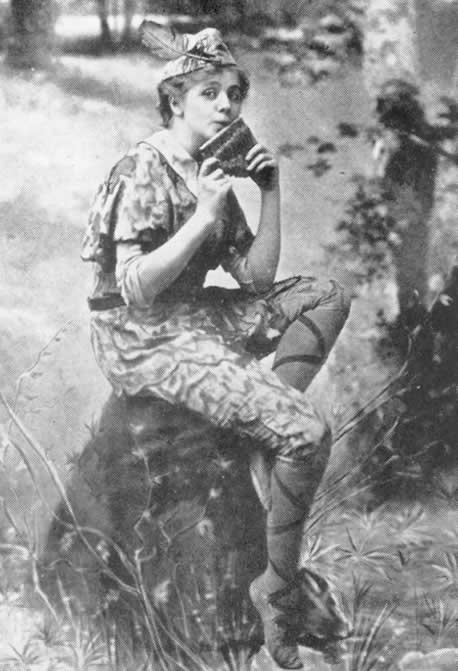
Actress Maude
Adams in her role as Peter Pan from a 1906 theatre program.
American stage actress Maude Adams was thirty-three years old when she accepted the title role in James M. Barrie's play "Peter Pan." The show opened at the Empire Theatre in New York in November 1905 under the management of Charles Frohman, a brother of Daniel Frohman, husband of Margaret Illington. (Illington was the only actress Clemens would later appointed to his Aquarium Club.) On November 15, 1905 Clemens attended a performance of "Peter Pan" and mentioned it in an interview the following day with journalist Marlen Pew. Clemens called it "a play which is without a defect.... It is consistently beautiful, sweet, clean, fascinating, satisfying, charming, and impossible from beginning to end. It breaks all the rules of real life drama, but preserves intact all the rules of fairyland, and the result is altogether contenting to the spirit. The longing of my heart is a fairy portrait of myself: I want to be pretty; I want to eliminate facts and fill up the gaps with charms" (Scharnhorst, p. 528).
Where or when Clemens may have first met Maude Adams has not been established. But his personal notebooks indicate he had lunch with her in early February 1906. In 1906 Clemens had also established a friendship with writer Charlotte Teller. In September 1906 when Clemens wrote an advertising endorsement for Teller's book The Cage, he wrote it in the form of a personal letter to Maude Adams. Clemens also wrote an endorsement for Adams in her role as Peter Pan which was published in the Boston Globe prior to the show's opening in that city in October 1906: "It is my belief that Peter Pan is a great and refining and uplifting benefaction to this sordid and money mad age; and that the next best play on the boards is a long way behind it as long as you play Peter."
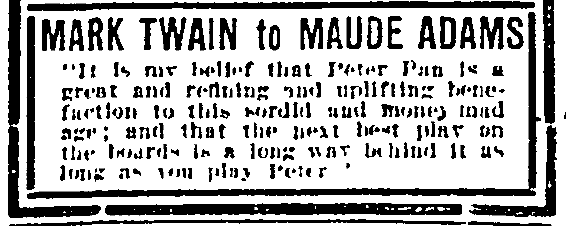
Advertisement from BOSTON GLOBE, October 9, 1906, p. 13.
Clemens's attraction to the joys of children and youth as presented by Maude Adams in the role of Peter Pan is symbolic of his later and continuing involvement with the girls who became his angel-fish. No letters from Maude Adams to Clemens are known to exist.
_____
HELEN SCHUYLER ALLEN
September 6, 1894 - June 29, 1956
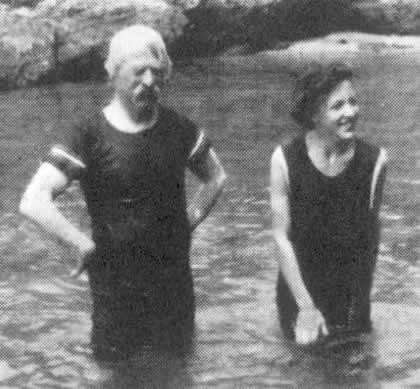
Samuel Clemens
and Helen Allen in Bermuda, 1908.
In his autobiographical dictation of April 17, 1908, Clemens described angel-fish Helen Allen, "perfect in character, lovely in disposition, and a captivator at sight!" (Cooley, p. 140). He later expanded upon these initial impressions in his personal writings as he came to know her better. Clemens met Helen Allen in Bermuda in 1908. She was the daughter of William Henry Allen and his wife Marion Elizabeth Schuyler Allen was American Vice-Consul to Bermuda serving under Maxwell Greene. Helen was the granddaughter of Charles Maxwell Allen who had been appointed American consul to Bermuda under President Abraham Lincoln. Clemens had met Charles M. Allen during his 1867 Quaker City excursion tour to the Holy Land. Helen's grandmother Susan Elizabeth Allen had known Clemens's wife Livy when Livy was a child. The Allen family offered Clemens their home as a place to stay during his trips to Bermuda and were his hosts during his final visit shortly before his death. Helen Allen's name is listed as a guest in his Stormfield guestbook for October 16 - 17, 1909 (Colley).
On May 17, 1915 Helen Schuyler Allen married Percy Walker Nelles who became the first Canadian admiral. The couple's first son Charles Macklem Nelles was born September 15, 1916 in Bermuda. Several personal observations Clemens wrote about Helen Allen and her family were published by John Cooley in Mark Twain's Aquarium: The Samuel Clemens Angelfish Correspondence, 1905-1910.
_____
LORAINE ALLEN
July 19, 1898 - May 17, 1984
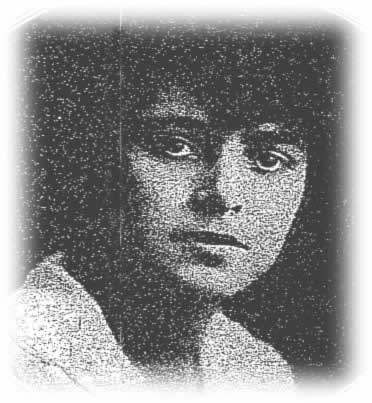
Photo of Loraine
Allen from THE NEW YORK TIMES, November 12, 1916, p. RPA 4.
On April 17, 1908 Clemens spoke of angel-fish Loraine Allen: "nine and a half years old, with the voice of a flute and a face as like a flower as can be, and as graciously and enchantingly beautiful as ever any flower was" (Cooley, p. 140). Loraine was the only daughter of George Marshall Allen and his wife Grace Fanshawe Allen. The family was wealthy with homes both in New York and New Jersey. In 1904 Loraine's father, George Marshall Allen, incorporated the Bermuda Electric Light, Power & Traction Company. It is likely that Clemens first met Loraine in Bermuda. On August 21, 1917 Loraine married Allan MacDougall at the family's country home Glynallen in Morristown, New Jersey. The couple divorced in 1941 and Loraine later married Godfrey Stephen Beresford. No correspondence between Loraine Allen and Clemens has been recovered.
_____
ETHEL BARRYMORE
August 15, 1879 - June 18, 1959
American actress Ethel Barrymore was the daughter of actors Maurice Barrymore and his wife Georgiana Drew. Georgiana Drew was the sister to actor John Drew, Jr. Clemens had been acquainted with John Drew, Jr. as early as April 1887 when Clemens appeared as the keynote speaker honoring Drew for his 100th performance in the play "The Taming of the Shrew." Ethel Barrymore's first appearance on the stage was in 1895 in "The Imprudent Young Couple" starring her uncle John Drew, Jr. and actress Maude Adams.
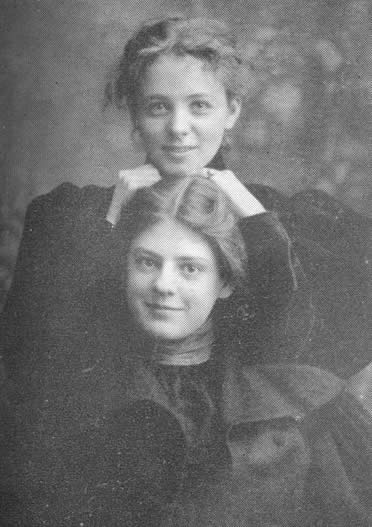
Actresses Maude
Adams (top) and Ethel Barrymore (bottom)
In her autobiography Memories, Barrymore recalled first meeting Clemens at Dublin, New Hampshire when she had traveled there to visit artist Joseph Smith. Samuel Clemens and Ethel Barrymore appeared together at a fund raiser for the Actors' Fund Fair in New York in May 1907. A newspaper gossip columnist reported on Clemens and Barrymore:
|
DOINGS AT ACTOR'S FUND FAIR New York, May 17. - A pantomime scene: Anne Hathaway's cottage at Stratford-on-Avon. The characters: Shakespeare and Anne? No. Mark Twain and Ethel Barrymore. They are discovered in a conversation that looks all-absorbing. They don't show that they know they are observed. Has nobody told them that the front wall of the room has been cut out, and that the street is crowded by people looking in? They gaze into each other's eyes soulfully, as though neither is aware of any other person on earth than t'other. If the dialogue could be heard it might run, "You are the greatest ever," There's been a greater than you, no never," and so on in adulent flattery. Is the play entitled "Proposing?" No. If I were asked to name it, I should say, "Posing." For Ethel, loveliest of this day pets of the stage, is never off guard. No camera could catch her in other than a pictorial pose. ... So young Ethel Barrymore is holding the bright center of the stage and old Mark Twain is circling in the outer dimness? Well, not much, and not any. This Mark isn't an easy mark to miss. He stands out for all the shots of publicity that go flying around. ... At the time of my description they are at the booth of the Players' club. ... As to Mark Twain and Ethel Barrymore in the pantomime of "Posing," it ended with his writing his name in as many of his books as the people would buy, and her selling by auction, at $30 a doll that she had dressed in imitation of herself in a play. - Salt Lake Herald, Sunday, May 19, 1907, p. 10. |
Barrymore met Clemens in New York the following year at a small but elaborate dinner party on February 13, 1908 hosted by publishing magnate Robert Collier. Clemens and Barrymore were seated together. The New York Times reported there were thirty guests and "the affair was intended to be informal and an exceptionally cozy little matter" ("Collie Ballet For Collier," The New York Times, February 14, 1908). Clemens later reported that he partied until after 4 in the morning (Shelden, p.197).
Ethel Barrymore's name was listed by Clemens in a handwritten guest list for an all-female "doe luncheon" in 1908 indicating they continued to socialize with one another. No correspondence between Clemens and Ethel Barrymore has been found.
_____
MARGARET GRAY BLACKMER
January 1, 1896 - May 1987
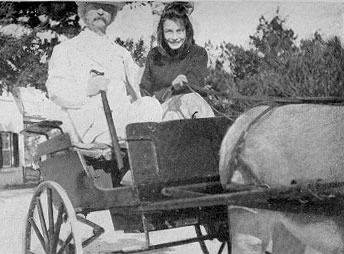
Samuel Clemens
and Margaret Blackmer, Bermuda 1908
Clemens spoke of his first meeting with angel-fish Margaret Blackmer in Bermuda in his autobiographical dictation of February 13, 1908. He described her laugh as "the rippling laugh that a happy brook makes when it breaks out of the shade into the sunshine. ... We were close comrades -- inseparables in fact -- for eight days" (Cooley, p. 103). The two took daily excursions in a donkey cart around the island to a spot on the coastline called Spanish Point.
Margaret was the daughter of business tycoon Henry Myron Blackmer and his first wife Helen Kerr. Henry Myron Blackmer was a New England lawyer who had gone to Colorado and made a fortune as a financier of railroads, a banker and oilman. Henry Blackmer had a reputation as a lavish spender.
Elizabeth Wallace, a dean at the University of Chicago, was also wintering in Bermuda in 1908 and made the acquaintance of both Clemens and Margaret Blackmer. Wallace wrote of their acquaintance in Chapter One of her book Mark Twain and the Happy Island describing how Mark Twain presented Blackmer with a tiny seashell. According to Wallace, "Some time afterwards Mr. Clemens had two pretty gold-enameled replicas of the shells made, and he presented one of them to Margaret. The other he hung on his watch-fob."
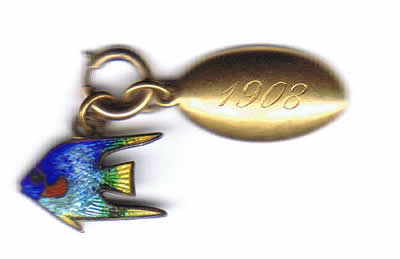 |
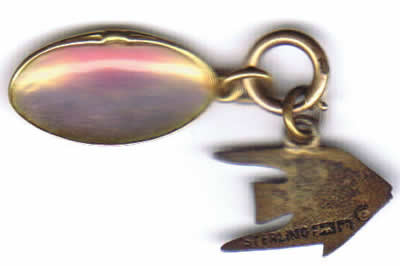 |
In Chapter Two of her book Wallace published additional photos of Clemens and Blackmer and in Chapter Four, she described touring the island of Bermuda with Clemens and Margaret riding in the donkey cart pulled by a donkey named Maude.
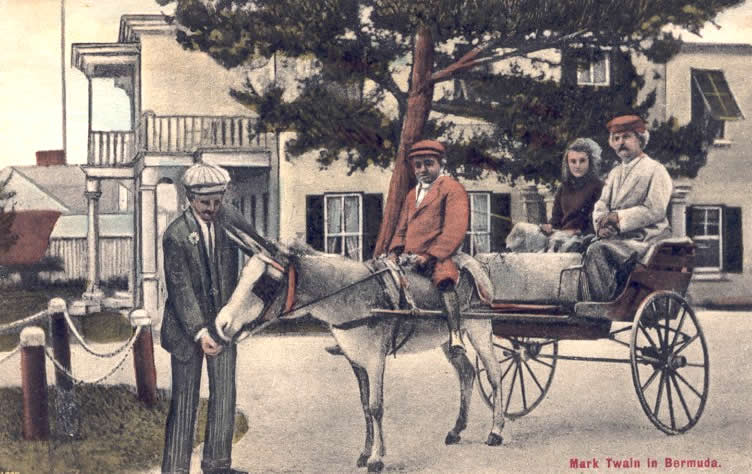
Colorized postcard
featuring Clemens and Margaret Blackmer in the donkey cart in Bermuda.
On April 17, 1908 Clemens, back in New York, dictated in his autobiography: "Margaret's father will bring her down from her school at Briarcliff on the Hudson six days hence to visit me -- as I learn per her letter of five days ago -- and then she will go with me to play at the Children's Theatre, where, as Honorary President of that admirable institution, I am to say a few words. Clemens's appearance at the Children's Theatre was reported in the New York Times on April 24, 1908. Margaret and her mother again visited Clemens at Stormfield in September and October 2 - 5. In November 1908 Helen and Henry Blackmer were divorced in Sioux Falls, South Dakota. In December 1908 Margaret and her mother Helen again visited Clemens at Stormfield. When Elizabeth Wallace visited Clemens at Stormfield he discussed Margaret with her. Recalling that conversation in Chapter 11 of her memoir, Wallace wrote:
"She is a dear womanly child," said Mr. Clemens, "and we had one conversation together which convinced me more than ever of her sweet consideration for others. She was telling me how she intended to bring up her children, and what were her plans for their education. There were to be two, a boy and a girl. The girl was to be named after her mother. I asked her what the boy's name would be, and she replied, with a reproachful look in her brown eyes: 'Why, Mr. Clemens, I can't name him until I know what his father's name is.' Now, wasn't that truly thoughtful?"
On April 10, 1909 Clemens wrote:
Margaret is due to arrive here with her mother at 5:45 this evening. It is an event: an event like the advent of spring after winter. The scamp will be welcome. Also her mother (Colley).
In May 1909 Clemens attended Margaret's school to watch her perform as Puck in "A Midsummer Night's Dream." Wallace also quoted a letter from Clemens discussing Margaret in the play in Chapter Thirteen of her book.
In 1924 Helen's father Henry Blackmer fled to Europe in the wake of the Teapot Dome scandals and lived the life of a rich American exile. In 1920 Margaret Blackmer married Denver native Erle Oatman Kistler. The couple had three children. Clemens's autobiographical dictations about Margaret and their correspondence was published by by John Cooley in Mark Twain's Aquarium: The Samuel Clemens Angelfish Correspondence, 1905-1910. (For more info on Henry Blackmer, see "Darling of the Gods," in Time magazine, October 3, 1949.)
____
MARJORIE BRECKENRIDGE
June 8, 1893 - September 1980
Marjorie Breckenridge was born in Brooklyn, New York, the daughter of Maude Summerfield and Rollin Breckenridge. The 1900 census shows the Breckenridge family living with Marjorie's paternal grandfather John Breckenridge in Milburn Township, Essex County, New Jersey. Her grandfather John Breckenridge was a minister. Her father Rollin Breckenridge was a lawyer. In 1907, Maude Summerfield Breckenridge remarried to New York attorney Henry Murray Dater. In the 1910 census Marjorie and her younger brother John Breckenridge were listed as the stepchildren of Henry M. Dater living in Brooklyn, New York. Henry Dater had a summer home in Redding, Connecticut which was a short walk from Samuel Clemens's Stormfield home. Clemens probably met Marjorie in the summer of 1908 after he moved to Redding. Her name was the final name listed in a list of angel-fish prepared in the summer of 1908. Breckenridge's name appears in the Stormfield guestbook for September 8 - 9, 1908 (Colley).
Marjorie graduated from New Haven Normal school of Gymnastics. Prior to her marriage she was employed by the YMCA in New York City and in New Britain, Connecticut. She married James W. Dayton (born June 5, 1893 - died May 1977), who later became director of the state Extension Service for Massachusetts by 1952 and was later an associate dean for University of Massachusetts. Marjorie was a long-time member of the Women's Club in Amherst, Massachusetts as well as the Amherst Stamp Club and several national philatelic organizations. She was a second cousin of John Cooley who became interested in her acquaintance with Samuel Clemens and later edited Mark Twain's Aquarium: The Samuel Clemens Angelfish Correspondence, 1905-1910. At the time of her death in September 1980 she was survived by her son James W. Dayton, Jr. and a daughter Edith R. Congett of Willoughby, Ohio.
Clemens's correspondence with Breckenridge consists of a few brief letters. No photos of Marjorie Breckenridge with Clemens are know to exist. On July 17, 1991 National Public Radio (NPR) featured an interview with Marjorie's son James Dayton who told of his mother's acquaintance with Clemens and her complaining about the fuss townspeople made when her well-known friend arrived in Redding for the summer.
JIM DAYTON: My mother when--she must have been about 16, I think--walked down the length of the station. She walked with him. 'There's Mark Twain. There's Mark Twain.' You could hear all of a sudden the crowd, and, yeah, it was he all right. She didn't like that--people crowds--whole crowd there, which I guess was substantial, on the platform.
Dayton further told the radio audience his mother never talked about being one of Mark Twain's angel-fish.
_____
BILLIE BURKE
August 6, 1885 – May 14, 1970
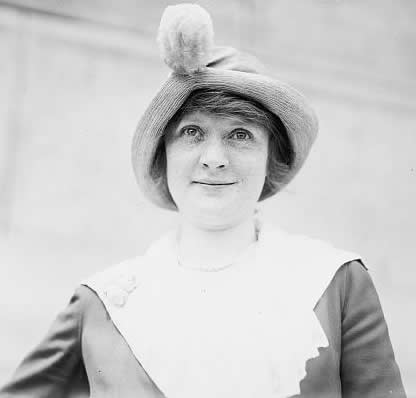
Photo of Billie
Burke from Library of Congress Prints and Photographs Division
Actress Billie Burke was born in Washington, D. C., the daughter of a Barnum and Bailey singing circus clown named William Burke and his wife Blanche Beatty. Blanche Beatty had been previously married to an Ohio oil refiner named George Hodkinson with whom she had four children. By some reports, Hodkinson's death had left Beatty a well-to-do widow.
When Billie was born she was given the name Mary William Ethelbert Appleton Burke. When she was eight years old, the family relocated to England where her father toured with the circus. The circus itinerary included playing Paris in the spring, Germany in the summer, Russia in the autumn, and London in the winter. Billie Burke was educated in Europe and later embarked on a stage career in London. She was a petite redhead with blue eyes, fair skin and freckles. In 1907 Broadway show manager Charles Frohman recruited Burke to come to New York to play opposite John Drew in the play "My Wife." It was a role that would establish Burke's talents as a comedienne. Billie Burke and her mother Blanche arrived in New York on August 3, 1907.
It is likely that Samuel Clemens first saw Billie Burke at her debut performance in August 1907 at the Empire Theatre where she played the role of Beatrice Dupree in "My Wife." A few months later Clemens reported in a letter to angel-fish Frances Nunnally that he was hosting a small dinner in his home at 21 Fifth Avenue for stage friends: "John Drew & his wife, Will Gillette, & Billie Burke -- excellent folk, & Billie is as good as she is pretty" (Cooley, p. 88).
Billie Burke rejected the typical women's fashions of the early 1900s which were heavy and dark and most often dressed in ruffles and ribbons. It was a style favored by Clemens for the young angel-fish who became his surrogate granddaughters. Clemens became a frequent backstage visitor to Burke's dressing room. In her autobiography Burke recalled:
He loved the theater, often occupying a box with friends to see our play, and he enjoyed coming backstage to visit Mr. Drew and me. It was always exciting and enjoyable to see him. He would shake that beautiful shock of snowy white hair and lean his wonderful head against mine to say, "Billie, we redheads have to stick together."
I thought nothing of making a trip to New York from either Boston or Philadelphia after the show if he had invited me to one of his charming little Sunday night dinners. He used to give these at that dear old house on lower Fifth Avenue, about Ninth Street, which had a quaint dining room of the period with sliding doors which pushed back into the walls after dinner; then one found oneself rustling with the ladies into the drawing room which looked out on the Avenue (Burke, p. 70).
On May 12, 1908 Clemens wrote to angel-fish Dorothy Quick that he had recently admitted actress Margaret Illington to his Aquarium and further committed, "There's lots of lady-candidates, but I guess we won't let any more in, unless perhaps Billy Burke (Cooley, p. 154). In September 1908 Clemens took another angel-fish Dorothy Sturgis to see Burke in her performance of "Love Watches" and visit with her afterwards in her dressing room.
Burke also visited Clemens in his home at Redding, Connecticut. Hers was the last name in his guest book for December 1908 appearing on December 27. Clemens wrote a tribute to her beside her name, "the young, the gifted, the beautiful" (Wagenknecht, p. 36).
In 1914 Billie Burke married Florenz Ziegfeld, Jr. who took over the management of her stage career. Burke's professional stage career included at least twelve Broadway plays and over eighty motion pictures. She is perhaps best known for her role as Glinda, the good witch, in the 1939 film The Wizard of Oz starring Judy Garland. Burke died May 14, 1970 in Los Angeles, California. The actual year of her birth remains open to debate. While many obituaries listed it as 1885, her tombstone in Kensico Cemetery, Valhalla, Westchester County, New York lists her year of birth as 1884. Ship manifests during her trans-Atlantic travels indicate that 1885 is the most likely year of her birth.
Several letters from Billie Burke to Clemens are in the Mark Twain Papers. Only one letter from Clemens to Burke has been recovered.
_____
MARGARET DOROTHY BUTES
January 17, 1893 - 1975
Dorothy Butes was regarded by Clemens as his first official angel-fish. In his autobiographical dictation of April 17, 1908 he described Dorothy Butes:
"There was never a lovelier child. English, with the English complexion; and simple, sincere, frank and straightforward, as became her time of life. This was more than two years ago. She came to see me every few weeks, until she returned to England eight months ago (Cooley, p. 138).
Margaret Dorothy Butes, born in London, was the daughter of Alfred Butes and his wife Janet Stratton Butes. Alfred Butes, also born in England, was a personal secretary, confidant and companion to New York publishing magnate Joseph Pulitzer. Prior to his employment with Pulitzer in the mid 1890s, Alfred Butes had served in Africa as a secretary to Sir Francis de Winton. One biographer described Butes as, "A persistent frock-coat wearer with the solemn air of a Sunday School superintendent, he moved about his business with silent efficiency, taking care to contract no awkward alliances (Pound, p. 302). Alfred Butes was an accomplished stenographer known for his discreet manner and he gained more of Pulitzer's confidence than most men ever enjoyed. Pulitzer provided a number of benefits for Butes and his family including a tour of Europe.
Clemens recalled that his first meeting with young Dorothy Butes came about because she "wanted to come and look at me" (Cooley, p. 138). This first meeting took place in New York City in 1906. Dorothy and her parents had arrived from Liverpool on the S.S. Majestic on August 29, 1906. The first recovered correspondence between Butes and Clemens is a letter from Dorothy dated October 24, 1906. In 1907 Alfred Butes resigned from his thirteen-year employment with Joseph Pulitzer, forsaking a position as trustee of Pulitzer's estate and a $50,000 legacy set up for him in Pulitzer's will. Butes accepted a position with British publishing giant Alfred Charles William Harmsworth, known as Lord Northcliffe, and returned to London. Pulitzer biographers believe Butes's desertion of Pulitzer was a blow from which Pulitzer never recovered. Dorothy Butes returned to England in July 1907 and Clemens was described as "heart sick" over her departure (Cooley, p. 188). Dorothy Butes and Clemens maintained their correspondence and future visits to Clemens were planned for the summers. Lord Northcliffe was among one of the early visitors to see Clemens when he moved into his new home in Redding, Connecticut in the summer of 1908.
When Clemens's assistant Ralph Ashcroft traveled to London on business in 1909, he carried a message to Dorothy Butes from Clemens. In a letter dated February 9, 1909 Clemens reported that Ashcroft "dined with her & her parents & they all went to the theatre (Cooley, p. 249). Evidence indicates a number of letters Clemens wrote to Dorothy Butes have not yet been recovered.
_____
MARGERY HAMILTON CLINTON
June 24, 1887 - February 1980
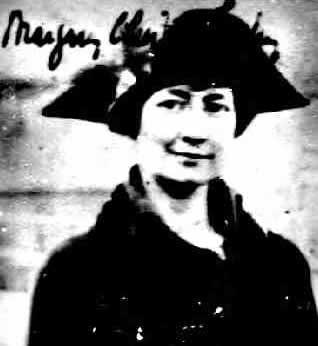
Margery Hamilton
Clinton, from her passport photo.
Margery Clinton was a neighbor on 57th Street in Tuxedo Park, New York to Clemens's friend Mary Benjamin Rogers who was the daughter-in-law of Clemens's financial advisor Henry Huttleston Rogers. The first recovered item of correspondence between Clemens and Clinton is dated New Year's Day, 1907. On August 18, 1908 Clemens inscribed a copy of a 1906 edition of Adventures of Huckleberry Finn to Clinton writing:
"Let a sleeping dog lie."
It is a poor old maxim, & nothing in it: anybody can do it, you don't have to employ a dog (Burt, 2008).
The Clemens and Clinton correspondence continued through at least December 1909. Clinton visited Clemens at Stormfield at least three times -- in July 1908, October 1908 and February 1909. On February 9, 1909 Clemens described Margery Clinton in a letter to angel-fish Frances Nunnally:
The plumber is coming Feb. 23d; a girl you would greatly like. She isn't a M.A. [angel-fish], but is not without good qualities, nevertheless. She is official plumber of Stormfield, by her own request, but doesn't know how to plumb. Name, Margery Clinton (Cooley, p. 249).
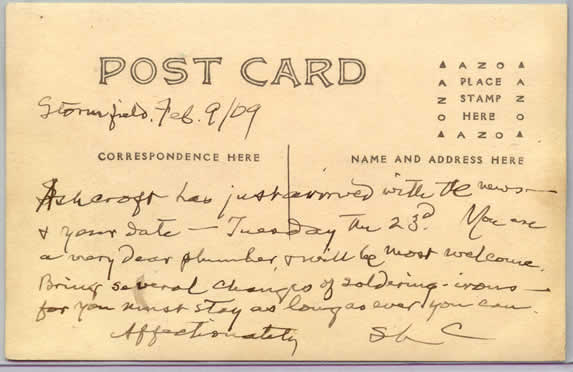
Postcard to
Margery Clinton from Clemens reading in part,
"You are a very dear plumber & will be most welcome. Bring several
changes of soldering-irons -- for you must stay as long as ever you can.
Affectionately, SLC
Margery Hamilton Clinton was the daughter of renown New York architect Charles William Clinton and his wife Emily de Silver Gorsuch. She corresponded with Clemens over a period of several years from 1907 - 1909. According to one of her friends:
It is not surprising that Mr. Clemens enjoyed this correspondence for Margery was one of the wittiest and most entertaining persons that I have had the good fortune to meet. She sometimes used to amuse us by giving monologues which seemed to me almost as good as those given by the famed Miss Ruth Draper, who after all was a professional (Rushmore, p. 193-94).
Margery Clinton married naval Commander Lamar R. Leahy in September 1919. Leahy preceded her in death on October 10, 1958.
_____
IRENE GERKEN
circa 1896 - May 19, 1969
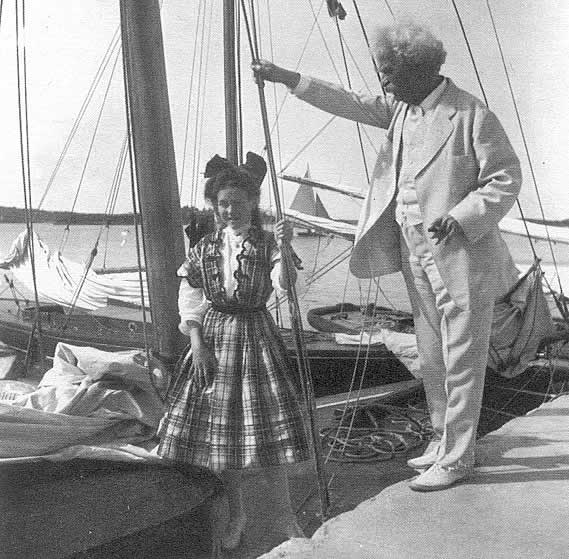
This photo
of Irene Gerken and Clemens appeared in THE NEW YORK TIMES, April 19,
1908.
Gerken was not identified in the TIMES photo.
Samuel Clemens met angel-fish Irene Gerken in Bermuda on his second trip to the island in January 1908. Elizabeth Wallace, a dean at the University of Chicago, was also wintering in Bermuda in 1908 wrote of Irene in Chapter Eight of her memoir Mark Twain and the Happy Island, "She was Margaret's [Blackmer's] direct successor in the donkey cart, and many a lovely morning she and Mr. Clemens and Maude ambled off to Spanish Point, while the faithful followed or preceded, according to Maude's gait."
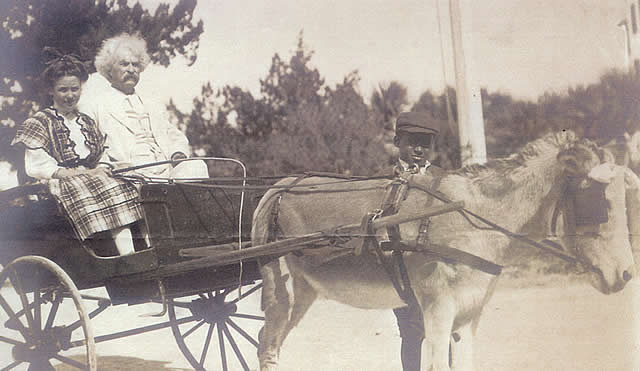
Irene Gerken and Clemens in the donkey cart, Bermuda 1908.
Photo from and courtesy of the Kevin
Mac Donnell collection.
On April 17, 1908, back in New York, Clemens dictated the following passage for his autobiography:
Irene Gerken, of 75th Street, New York, that beautiful and graceful and altogether wonderful child -- I mean fairy -- of 12 summers. To-morrow she will go to a matinee with me, and we are to play billiards the rest of the day. In Bermuda, last January, we played much billiards together, and a certain position of the balls is still known by her name there. When her ball backed itself against the cushion and became thereby nearly unusable, she was never embarrassed by that defect but always knew how to remedy it: she just moved it out to a handier place, without remark or apology and blandly fired away! Down there, now, when a ball lies glued to a cushion, gentlemen who have never seen that child lament and say, "O hang it, here's another Irene!" (Cooley, 139-140).
Samuel Clemens, Henry H. Rogers and Irene Gerken -- at the Princess Hotel in Bermuda. (Irene Gerken identified by her granddaughter, Irene Harlow.) Photo from and courtesy of the Kevin Mac Donnell collection.
Again on March 10, 1909 Clemens dictated the following about Irene Gerken and a conversation he had about her with his secretary Isabel Lyon::
We drifted into an incident of a few weeks ago, where I called at the private school in New York to see one of my little angel-fishes, Irene, and was refused permission to see her. The austere old virgin to whom the school belongs informing me it was against the rules for her young girls to receive visitors during school hours. My vanity was badly hurt, my dignity had been trampled under foot; I had been treated just like an ordinary human being, instead of as clay of the salt of the earth, and I could not endure it. I got a letter right away, as soon as I was back in Stormfield, from Irene, saying that her special teacher, Miss Brown, was ashamed of the fact that I had been treated just as the rules required ordinary visitors to be treated, but if she had known it was I she would have dismissed her class immediately, and I could have had Irene into my taxicab and carted her off to her home (Cooley, p. 254).
Irene Gerken, of 52 West 75th Street, New York was born in 1896. Her parents were Frederick Gerken and his wife Charlotte Beeker. Frederick Gerken was a German-born immigrant who had come to New York in 1871. Gerken was notable for his remarkable business acumen, especially in real estate development. He was chiefly responsible for the development of the town of Deal, New Jersey and built a casino there. The 1910 census shows the family had four live-in servants in their home. Frederick Gerken's name frequently appeared in the press in conjunction with his steam yachting, horse racing, and real estate ventures. He was instrumental in organizing the Empire City Trotting Association of New York and had been of the best known amateur drivers of trotting horses. The family spent part of their winters in Bermuda and summers at their home in Deal, New Jersey.
On November 24, 1915 Irene Gerken married attorney Joseph L. Egan. Joseph Egan advanced through the ranks of Western Union Telegraph company to eventually become president of that enterprise. The couple had three children -- Joseph, Jr., Ronald and Irene Marie who later married Lawrence J. O'Brien, son of the former mayor of New York. Joseph Egan died in Monte Carlo on December 6, 1948. Irene Gerken Egan died May 19, 1969. A number of letters Clemens wrote to Irene Gerken have not been recovered..
_____
DOROTHY HARVEY
October 23, 1894 - April 3, 1937

Dorothy Harvey
and her father George Harvey with Clemens.
Dorothy Harvey was the only child of Colonel George Brinton McClellan Harvey and his wife Alma Parker. George Harvey, a political journalist and diplomat purchased the North American Review in 1899 and became president of the publishing house of Harper and Brothers in 1900. In 1906 Harvey was the first person to publicly endorse Woodrow Wilson as a presidential candidate. Harvey worked closely with Clemens publishing twenty-five installments of Clemens's Autobiography in the North American Review from September 1906 through December 1907.
In his personal notebook for June 1908, Clemens listed Dorothy Harvey of Deal Beach, New Jersey as a member of his "aquarium." Clemens's guestbook for Stormfield indicates that Dorothy Harvey and Louise Paine, the daughter of his official biographer Albert Bigelow Paine, were the first two angel-fish to visit Clemens in is new home in Redding, Connecticut. The two girls spent eight days at Stormfield the first week of July 1908 (Colley).
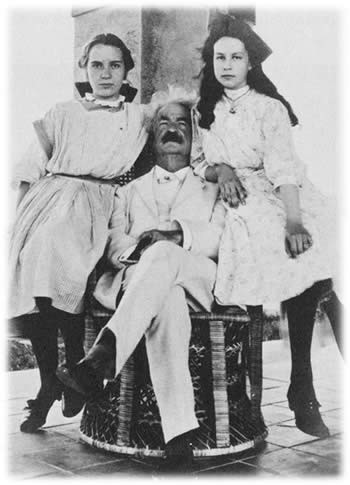
Louise Paine,
Clemens and Dorothy Harvey
In October 1908 Clemens attended a birthday party for Dorothy Harvey. One week later on October 30, 1908 Clemens wrote Dorothy Harvey a playful letter congratulating her on being fourteen for one week. Clemens wrote:
I had a most lively time down there. I wish I could have those free-gratis-for-nothing-voyages-&-nothing-to-do-but-look-at-you every day. I should grow fat and satisfactory (Cooley, p. 227).
Clemens added a postscript: "P.S. I am ever so glad the pin pleases you" (Cooley, p. 227).
Dorothy Harvey married Marcellus H. Thompson on August 12, 1914 at Deal, New Jersey. Thompson was the son of John T. Thompson, the inventory of the submachine gun. Harvey and Thompson had one daughter Dorothy Marcelle Thompson, born August 24, 1915.
In 1923 George Harvey was appointed ambassador to Great Britain and his daughter and granddaughter visited there. Newspapers reported that Dorothy Harvey Thompson danced frequently with the Duke of Windsor and then Prince of Wales. In 1929 Dorothy Harvey divorced Marcellus Thompson and a few days after the divorce married Augustus Smith Cobb on February 14, 1929. Cobb was a vice president of Bankers Trust Company in New York.
On April 3, 1937 Dorothy Harvey Thompson Cobb died of a gunshot wound to her right temple. Augustus Cobb told the press his wife had been suffering from tuberculosis and her death was ruled a suicide. She was survived by one daughter Dorothy Marcelle Thompson (later identified as Dorothy M. Maynard). Her estate, valued at slightly over $148,000, was willed to her husband, her daughter and three stepdaughters.
_____
MARGARET ILLINGTON
July 23, 1879 - March 11, 1934
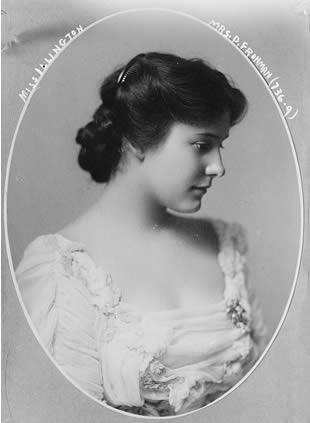 Margaret Illington, actress whose birth name was Maude Light. |
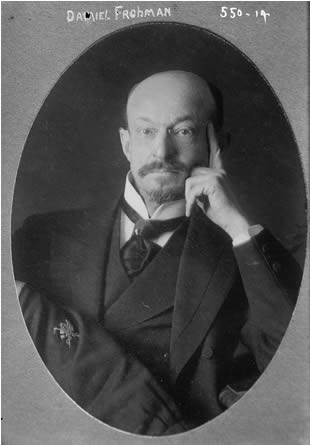 Daniel Frohman, renown theater manager and first husband of Margaret Illington. |
| Photos from Library of Congress Prints and Photographs Division. | |
Margaret Illington, a well-known stage actress, was the only adult female who Clemens listed in his roster of angel-fish. Illington was born Maude Light in Bloomington, Illinois on July 23, 1879. Her parents were J. H. and Ellen Mary Light. Maude Light, who had been interested in performing since childhood, received her education at Illinois Wesleyan University and Conway's Dramatic School in Chicago. Seeking her career on the stage, she moved to New York and was hired by one of America and Europe's most successful theatrical managers, Daniel Frohman. Light adopted the stage name Margaret Illington, a combination of the words "Illinois" and "Bloomington" in honor of her old hometown. Illington made her first professional stage appearance on September 3, 1900 at New York's Criterion Theatre in "The Pride of Jennico." A string of performances in other plays followed. Illington married her manager Daniel Frohman in November 1903. Frohman, born August 2, 1851 was twenty-eight years older than Illington.
Daniel Frohman and Clemens had been involved in theatrical ventures since the mid 1880s. In 1881 Frohman was manager of the Madison Square Garden Theatre and in 1886 assumed management of the Lyceum Theatre. In 1886 Frohman had produced Mark Twain's play "Colonel Sellers" in Hartford, Connecticut. Frohman had also been involved in adapting Twain's The Prince and the Pauper for stage production. The date that Clemens first met Margaret Illington has not been established. However, in May 1907 Clemens was involved in fund raising with one of Daniel Frohman's charity projects, an actor's fund fair. News reports of the events of that day later stated that Clemens had publicly bestowed a kiss on Margaret Illington. Further testimony to the affection Clemens held for Margaret Illington was reported by Katharine Clemens in her memoir "I Knew Mark Twain." According to Mrs. Clemens:
Mark (his beloved wife was then dead) came to lunch with us at Delmonico's Restaurant in New York to meet some other cousins, the James Brent Clemenses of New York. We were standing near the front door of the restaurant when an open victoria drew up to the curb, in which sat in all her glory the beautiful actress Margaret Illington and Mark Twain wearing one of his famous white suits, and without a hat. When the carriage stopped, he kissed her goodbye, and when she drove off, he entered the restaurant. (Mark Twain Journal, Spring/Fall 1999, p. 57.)
On May 18, 1908 Clemens wrote to another member of his aquarium, Dorothy Quick, that Margaret Illington and her husband Daniel Frohman had dined with him the previous Sunday, May 10 at his 21 Fifth Avenue residence in New York. Clemens wrote:
Margaret Illington has been trying to get into our Aquarium, & I wouldn't let her; but Sunday night she came here to dinner with her husband (Daniel Frohman), & she was dressed for 12 years & had pink ribbons at the back of her neck & looked about 14 years old; so I admitted her as an angel-fish, & pinned the badge on her bosom. There's lots of lady candidates, but I guess we won't let any more in, unless perhaps Billy Burke. (Cooley, p. 154).
By the summer of 1908, Clemens had added Margaret Illington's name to the roster of angel-fish and had listed her husband Daniel Frohman as "Legal Staff" (Cooley, p. 195). As an observer looking on the marriage of Frohman and Illington, Clemens witnessed what marriage between an older man and an apparent child bride would be like.
In October 1908, the New York newspapers began reporting that Illington's health was suffering under the strain of her acting career. By February 1909 the press was reporting that Frohman and Illington had decided on an amicable divorce. Illington told reporters she craved a domestic life and children of her own rather than a career on the stage. In November 1909 Illington obtained a divorce from Frohman in Reno, Nevada and a few days later remarried Major Edward J. Bowes, an officer in the Reserve Corp and a wealthy real estate developer from San Francisco and President of Narrow Land Company of Tacoma, Washington. Bowes, born June 1874, was a man closer to Illington's own age than Daniel Frohman. Years after their marriage, the couple told an interviewer they had fallen in love at first sight.
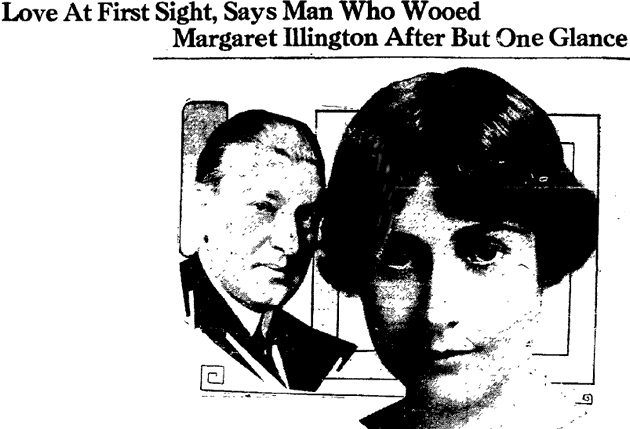
Headlines from
Frederick
[Maryland] Post,
August 17, 1925, p. 7.
Clemens had no doubt been following the news reports of Margaret Illington's career, divorce, and remarriage. On January 26, 1910, two months after her remarriage, he wrote her from Hamilton, Bermuda, perhaps responding to a letter from her she had written to him after his daughter Jean's death the previous month:
I am so glad to know you are happy! for I love you so. Some are born for one thing, some for another, but you were especially born to love and be loved, and be happy -- and so things are with you now as they ought to be (Cooley, pp. 270-71).
Clemens died a few months after this letter to Illington and no others to her have been recovered. A copy of his book What Is Man? was given to Illington -- a copy he had inscribed for her and set aside for her "after she was old enough to understand it" ("Miss Margaret Illington's Treasure," Duluth [Minn.] News Tribune, July 18, 1915, p. 9).
Illington did not retire from the stage for a life of domestic bliss. She and her second husband Edward Bowes moved to the east coast where he became a leader in the theatre, radio and entertainment industry. In 1918 he built the Capitol Theatre in New York, one of the first motion picture "palaces" and eventually began radio broadcasts from the facility. In 1922, Bowes became vice president of the Goldwyn Pictures Corporation which merged two years later to become Metro-Goldwyn-Mayer. Bowes eventually originated a radio broadcast called "Amateur Hour" which would later be hosted by Ted Mack. The radio show was an early forerunner of such television shows as "American Idol" and "America's Got Talent" that are now popular in the 21st century.
Margaret Illington Bowes died on March 11, 1934 in Miami Beach, Florida with Bowes by her side. The couple had no children. She was buried in Sleepy Hollow Cemetery in Tarrytown, New York. Edward J. Bowes died June 13, 1946 and is buried by her side.
_____
MARY "PADDY" MADDEN
1888 - ?
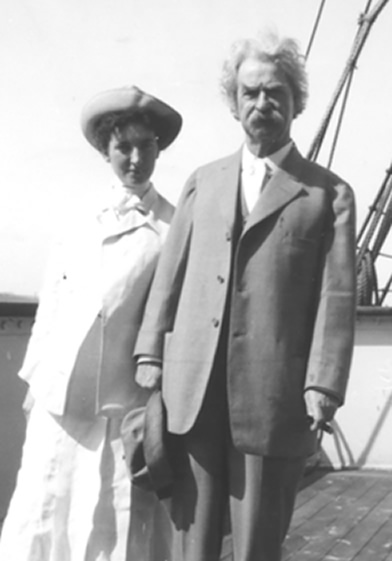
Photo of Paddy
Madden and Clemens courtesy of the Mark
Twain Papers, University California at Berkeley.
Clemens first met Paddy Madden in January 1907 on a return voyage from Bermuda to New York aboard S. S Bermudian. The ship's manifest for that trip lists Miss Mary Madden, age nineteen aboard the boat along with Samuel Clemens, the Reverend Joseph Twichell, and Clemens's secretary Isabel Lyon. No other passengers named Madden are listed for that trip. The voyage from Bermuda to New York lasted two days -- January 7 through January 9, 1907. Isabel Lyon recorded in her journal that as the ship left Bermuda a pretty girl from the Upper West Side named Paddy was by his side (Hoffmann, p. 75). Clemens returned to his home at Fifth Avenue in New York and when his book Christian Science was published the following month (February 1907), he asked his publisher Harper & Brothers to send a copy to Paddy Madden at 3 West 104th street. His personal notebooks also indicate he planned to send her his photo. In his biography, Mark Twain in Paradise: His Voyages to Bermuda, Donald Hoffmann comments that this friendship with Paddy Madden was an indication that "Clemens had already begun making friends at sea with little girls" (p. 78). However, according to the ship's manifest, Madden was nineteen at the time she met Clemens and older than most candidates for his angel-fish aquarium.
In March 1907 Clemens decided to take another trip to Bermuda. Isabel Lyon telephoned Paddy Madden and issued an invitation for her to accompany them on the five day excursion -- four days round trip on ship and one day on the island. Lyon reported that the invitation "delighted her soul" (Hoffmann, p. 78). Clemens reported to his daughter Clara, "We invited Paddy, by telephone, to go along with us, & her father has given his consent" (Hoffmann, p. 78). Clemens, Lyon and Madden departed New York on March 16. Also on board the ship to Bermuda was president of Harvard University Charles W. Eliot. Lyon recorded in her journal that Paddy:
...proves a delightful bait for the very nicest men on board. She sat beside President Eliot and seemed to delight him with her empty little remarks. She loves ice cream, but not candy, and she never drinks coffee, all of which she says with a conviction that makes you interested in what she is saying ... She says a 5-page prayer to the Virgin 5 times a day when she isn't too sleepy, and so on and so on, and she is so pretty (Hoffmann, p. 78).
Clemens, Lyon and Madden returned to New York on March 21 on the S. S. Bermudian and again the ship's manifest recorded Miss M. Madden as a nineteen year old passenger. Two letters Madden wrote to Clemens are on monogrammed MDM letterheads. No further identification of Mary "Paddy" Madden has been established and no letters written by Clemens to her have been recovered.
_____
HELLEN ELIZABETH MARTIN
abt. 1897 -
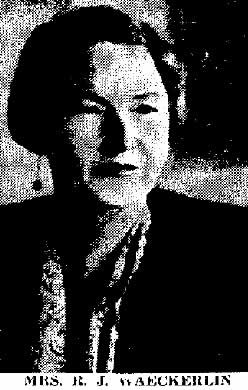
Hellen Martin
later married Swiss consul to Jamaica Rudolf James Waeckerlin.
Photo from Winnipeg
Free Press,
October 9, 1948, p. 14.
Hellen Martin was the daughter of Canadian-born Robert Dennison Martin and his Scottish-born wife Helen Moncrieff Morton. Martin had achieved financial success in Canada as a grain dealer, establishing a company later known as British Empire Grain Company, Limited. Hellen's father, Robert D. Martin died at his home in No. 1 Murray avenue, Westmont on June 28, 1905. Martin was survived by his wife and five children. At the time Clemens met Hellen Martin and her mother in Bermuda, Mrs. Robert D. Martin was a wealthy widow.
Clemens made two trips to Bermuda in the winter of 1908. His autobiographical dictation for April 17, 1908 records that he had made the acquaintance of Hellen Martin and added her name to the list of his angel-fish. Regarding Hellen, he said, "Hellen Martin, of Montreal, Canada, a slim and bright and sweet little creature aged ten and a half years (Cooley, p. 140). In his personal notebook for June 1908 he recorded Hellen's age as 12 and her address as "1 Murray ave, Westmount, Montreal" (Cooley, p. 165).
Examination of the ship manifests coming from Bermuda to New York indicates that eleven-year-old "Helen Martin" and her mother, also named Helen, arrived in New York from Bermuda on board the S. S. Trinidad enroute to their home in Montreal on March 30, 1908. In April Hellen wrote Clemens from Montreal sending him her love. The only correspondence from Clemens to Hellen Martin that has been recovered is a draft of a letter he wrote back to her contained in his autobiographical dictation for April 17, 1908. He wrote: "I miss you, dear Hellen. I miss Bermuda too, but not so much as I miss you; for you were rare, and occasional, and select, and Ltd" (Cooley, p. 141).
Hellen Martin later married Rudolf James Waeckerlin, the Swiss consul to Jamaica and made her residence in Kingston, Jamaica. Her husband R. J. Waeckerlin was also managing director of the Rum Company Jamaica, Ltd..
_____
GERTRUDE NATKIN
April 1890 - October 1969
Samuel Clemens never considered Gertrude Natkin a member of his angel-fish club. He first met the young teenager in December 1905 in New York as she was leaving Carnegie Hall. (It would be almost a year before he conceived the idea of forming an association of surrogate granddaughters.) Natkin's first letter to Clemens dated December 27, 1905 speaks to the nature of their first meeting:
Yesterday a very happy little girl went home, thinking only of dear Mr. Clemens. I wish to thank you very much for being so kind. I really think you must have seen in my face that I was yearning to speak to you and it was kind of you to gratify my wish.... I am the little girl who loves you. (Cooley, p. 8).
Gertrude Natkin was the youngest of ten children of Russian Jewish immigrant Simon Natkin and his wife Florence. Simon Natkin was employed as sexton of Shaaray Tefilia, West End Synagogue. Only a week prior to meeting Gertrude Natkin, Clemens had participated in a benefit to aid the cause of Russian Jews who had suffered in an abortive Russian revolution of 1905. There is no current evidence that Simon Natkin or his family were present at Clemens's appearance at the Jewish fundraiser, but the Natkin family was no doubt aware of the efforts Clemens was making on the behalf of Russia.
The 1900 US census for New York shows the Natkin siblings included Benjamin, I. (Isaac) Newton, Harry, Bessie, Jennie, Miriam, Milton, Rosa and Gertrude, the youngest at age ten.
The majority of the correspondence between Clemens and Gertrude Natkin covers a time period of only a few months. In February 1906 Clemens sent Natkin a copy of a favorite book Marjorie Fleming by Dr. John Brown. Marjorie Fleming a child prodigy who had died at the age of eight in 1811 had held Clemens's fascination for a number of years and he would later publish his own essay on Fleming titled "Marjorie Fleming, the Wonder Child" in 1909. A few days after receiving the book from Clemens, Natkin requested to be considered his own little "Marjorie" and thereafter often signed her letters in that manner and Clemens often addressed her as such. Their correspondence progressed to the point where the two were exchanging "blots" or kisses on paper.
On March 4, 1906 Clemens provided complimentary tickets to Gertrude Natkin and her mother for his 3:30 p.m. benefit appearance at at the Majestic Theatre in New York for the YMCA. The New York Times later reported on the near riot and the perilous jam from the crowd trying to gain entrance to hear Mark Twain's speech. Clemens's letter to Natkin a few days after his appearance contained an apology for not instructing her and her sister (Miriam Natkin apparently attended in her mother's place) to enter via the stage door. Natkin's letters to Clemens after attending the appearance indicate a growing affection for Clemens. When Natkin learned from Clemens's secretary Isabel Lyon that Clemens was suffering from a cold later that month, Natkin sent him flowers. Their correspondence progressed to telephone conversations, all the while Clemens reassuring Natkin she was his "dream grandchild" (Cooley, p. 23). On April 3, 1906 Isabel Lyon sent Natkin tickets for another Clemens appearance at Carnegie Hall on behalf of the Robert Fulton Association on April 19, 1906.
According to a letter Clemens dated April 8, 1906, that day was Natkin's sixteenth birthday. He wrote:
Sixteen! Ah, what has become of my little girl? I am almost afraid to send a blot, but I venture it. Bless your heart it comes with an ace of being improper! Now back you go to 14! -- then there's no impropriety. Good night, sweet fourteen (Cooley, p. 25).
Clemens apparently became uncomfortable with the amount of affection Natkin was showering upon him through her letters and his letters to her show a growing emotional distance from the teenager. Also, Clemens had become more closely involved in a relationship with Charlotte Teller, a thirty-year-old writer who lived near his 21 Fifth Avenue home and who held his fascination with her beauty, her writing projects, her involvement with Russian revolutionaries and her support of an upcoming visit of Maxim Gorky. Natkin wrote Clemens on April 16 that she had seen his cartoon in the newspaper. (The cartoon appeared in the New York World, April 13 and showed Clemens dethroning the Russian czar -- included in "Mark Twain on Czars, Siberia and the Russian Revolution.")
The evening of April 19, Natkin did visit Clemens backstage before and after his Fulton Association lecture. On April 27, Clemens wrote to thank Natkin for the flowers she had sent and in June Clemens sent Natkin a copy of his book Eve's Diary. In November Natkin sent Clemens a leather case for his birthday. On February 20, 1907 Natkin wrote Clemens that her sister had recently died. Miriam Natkin Robinson's obituary appeared in The New York Times on New Year's Day 1907. The letter reporting her sister's death was not the last correspondence from Natkin, but other notes that followed were infrequent and mostly birthday greetings from Natkin and exchanges of New Year's good wishes. Clemens had successfully distanced himself from the appearance of impropriety of the relationship.
The 1910 census for New York indicated twenty-year-old Gertrude Natkin still residing at 138 West 98th street with her parents and sisters Bessie and Cecilia. Gertrude listed no occupation. Bessie was employed as a real estate clerk and Cecilia listed her occupation as a school teacher. (An older sister Rose had died in 1903 and Gertrude's sister Jennie had married Gustave Goldstein.)
Gertrude's father Simon Natkin died in June 1914 after serving forty years as sexton of his congregation. The 1920 census for New York lists Gertrude, her mother and sisters residing with her brother Benjamin on West 96th street. Gertrude's occupation is listed as a secretary/stenographer for a leather importer. In June 1923 Gertrude's mother died. Her sister Bessie Natkin married David Pulvermacher in December 1923. Cecelia Natkin later married Herman Rubenstein.
Cecilia Natkin Rubenstein died in September 1932 and her surviving sister Gertrude was identified as Gertrude Dorfman. Jennie Natkin Goldstein died in February 1953 and her surviving sister Gertrude is again identified as Gertrude Dorfman. Bessie Natkin Pulvermacher died in January 1961 with Gertrude Dorfman identified as her sole surviving sister. Gertrude Natkin Dorfman's date of death is established as October 1969 and is based on an obituary announcement placed in The New York Times on October 14 announcing her funeral to be held October 15 at 2:30 p.m. at "The Riverside" at 76th street and Amsterdam Avenue. Gertrude L. (Natkin) Dorfman is identified as the aunt of Carolyn Morris and Joseph Jay Goldstein, children of Gertrude Natkin's late sister Jennie. The 1930 census for Flushing Township, New York City lists one Gertrude L. Dorfman married to William F. Dorfman, a compositor for an advertising company. Two children are listed -- a son named Everett and a daughter named Miriam.
The letters exchanged between Clemens and Natkin are housed in the Mark Twain Papers at the University of California at Berkeley. They were published by John Cooley in Mark Twain's Aquarium: The Samuel Clemens Angelfish Correspondence, 1905-1910.
_____
FRANCES NUNNALLY
February 27, 1891 - March 29, 1981
In his autobiographical dictation of April 17, 1908 Clemens described Frances Nunnally:
...school-girl, of Atlanta, Georgia, whom I call Francesca for short. I have already told what pleasant times we had together every day in London, last summer, returning calls. She was 16 then, a dear sweet grave little body, and very welcome in those English homes (Cooley, p. 138).
On June 8, 1907 Clemens sailed to England aboard the S. S. Minneapolis to accept an honorary degree from Oxford University. On board the Minneapolis were Frances Nunnally and her mother who were embarking on a tour of Europe. Nunnally was the daughter of James Hilliard Nunnally and his wife Cora Winship Nunnally of Atlanta, Georgia. James H. Nunnally was a prominent candy manufacturer whose initial business established in 1884 had grown to include factories and retail stores in Atlanta, Washington, D.C. and Miami, Florida. Nunnally was also a director of several Atlanta financial institutions. Frances Nunnally and her mother, along with Clemens and his party, lodged at Brown's Hotel in London and young Frances accompanied him around London to visit various dignitaries.
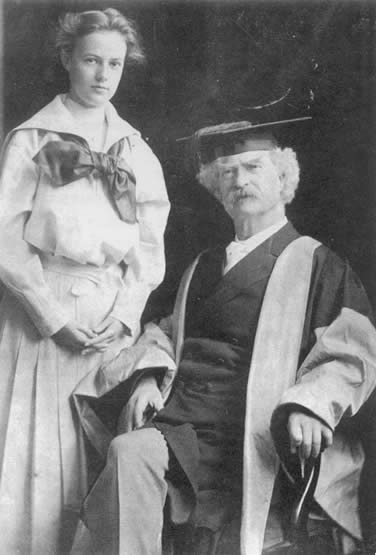
When Clemens
was photographed in his Oxford robes, Frances Nunnally stood beside him.
It was a picture he later kept on his bedroom dressing table.
Clemens left England to return to the United States on July 13, 1907 and Frances Nunnally and her mother Cora continued on their European tour. When the two returned to the United States in September 1907 they accepted Clemens's invitation to visit him at his home in Tuxedo Park, New York. Frances Nunnally returned to St. Timothy's School at Catonsville, Maryland near Baltimore that fall. Nunnally and Clemens maintained contact through their correspondence and in February 1908 Clemens mailed her an angelfish pin. On March 14, 1908 Clemens wrote her from Bermuda
Francesca,dear, I am taking the liberty of appointing you to membership in my "Aquarium" (Club) (Cooley, p. 122).
In June 1908 Clemens made arrangements to visit with the Nunnally family while they were in New York enroute on another summer tour of Europe. When they returned from Europe in September 1908, Frances Nunnally and her mother Cora visited with Clemens at his home in Redding, Connecticut. Frances Nunnally's name appears in the Stormfield guestbook for September 27 - 29, 1908 (Colley).
After she had again returned to her school at Catonsville, Clemens sent Frances a copy of Lucy Maud Montgomery's book Anne of Green Gables in October 1908. On June 9, 1909 Clemens delivered his final public speech at Nunnally's graduation from St. Timothy's and posed afterward for photographs with the graduates. The two continued to correspond through 1909.
On November 14, 1912 Frances Nunnally married John Charles Wheatley in Atlanta. The 1920 census lists Frances and John Wheatley residing with her parents and a contingent of servants on Peachtree Road in Atlanta. Wheatley was employed as a bond broker. By 1925 their marriage had ended in divorce. Frances Nunnally moved to Hollywood, California where she married John Fish Goodrich on April 11, 1925. Goodrich, a graduate of Cornell University, worked in Hollywood as a screen writer. The couple had one daughter born in 1926, also named Frances. Goodrich died in March 1936. Frances's father James H. Nunnally, died two years later in May 1938. At the time of his death, James H. Nunnally's estate was valued at over $7,600,000. Much of his wealth had been accumulated when he and Ernest Woodruff (who was married to Cora Winship Nunnally's first cousin) had helped finance a buyout of the Coca-Cola company in 1919. James H. Nunnally served on the board of directors for Coca-Cola for a number of years prior to his death. Frances Nunnally Goodrich and her daughter remained financially independent due to the family's accumulated wealth.
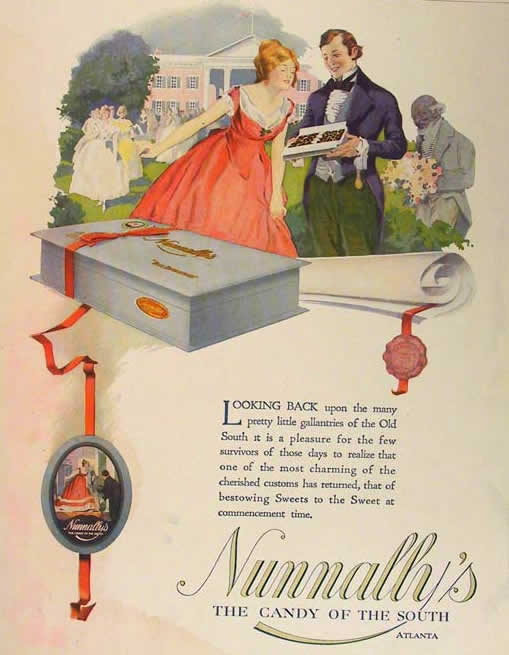
Advertisement
for Nunnally's candy circa 1920, the company owned by Frances Nunnally's father.
On December 11, 1965 Frances Goodrich and George Winzer, an Australian immigrant, filed a marriage license in Los Angeles, California. George Winzer was seven years older than Frances. She had formerly introduced Winzer to her family doctor as her chauffeur. George Winzer died in November 1973. Frances Nunnally Winzer died in March 1981 in La Jolla, California survived by her daughter Frances Goodrich Harpst. During her final years she had given away fortunes in Coca-Cola stock to Scripps Memorial Hospital in La Jolla, California. She also provided building funds for the University of California at San Diego; Coronado Hospital in Coronado, California and provided financial support to other institutions in southern California.
Correspondence between Nunnally and Clemens was published by John Cooley in Mark Twain's Aquarium: The Samuel Clemens Angelfish Correspondence, 1905-1910.
_____
LOUISE PAINE
August 5, 1894 - March 30, 1968
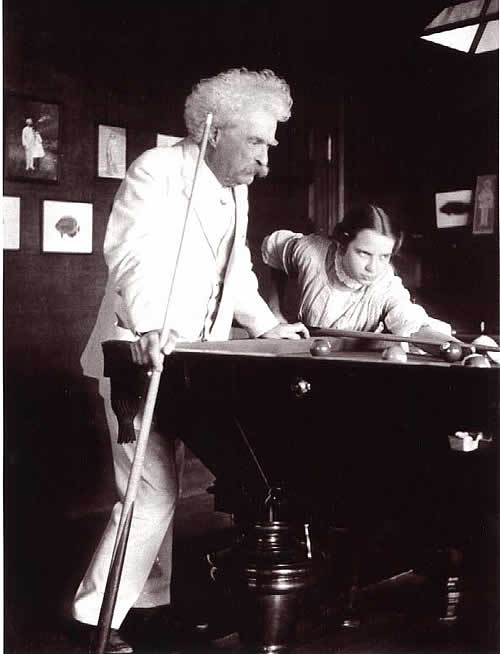
Samuel Clemens
and Louise Paine
Louise Paine was the daughter of Samuel Clemens's official biographer Albert Bigelow Paine and his wife Dora. Born in St. Louis, Missouri, Louise was the oldest of three children. Two younger sisters were Frances and Joy, both born after the family relocated to New York. By January 1906 Albert Bigelow Paine had received Clemens's blessing to serve as his official biographer and from that point onward Paine became Clemens's constant companion. About the same time that Paine became associated with Clemens, Paine purchased property in Redding, Connecticut and encourage Clemens to do the same. When Clemens conceived the idea of an Aquarium Club made up of surrogate granddaughters, it was natural that Paine's teenage daughter Louise would be included in the membership.
In 1959 Louise Paine's memoir of Clemens was published in The Twainian. She recalled:
The first time I saw this extraordinary man was at dinner in his home in New York in 1906....He was a charming host. He looked just like his pictures to us three little girls as to my mother and father. Moreover, there was a dinner to delight children, topped off with fairy-like mousse, piled high in a crystal bowl and accompanied by a sauce of big, red strawberries. Had he remembered that, at our age, dessert was at least as impressive as fame? (Moore, p. 3).
Louise Paine recalled visiting with Clemens again in the following spring and attending a theatre matinee, having breakfast in bed, living like a princess, and riding in the upper decks of the buses of Fifth Avenue. When Clemens moved from New York to his new home in Redding, Connecticut on June 18, 1908, Louise Paine and her father, along with reporters and photographers accompanied him on the train. The Paine family lived within walking distance of Clemens's Redding home and Louise and her sisters could walk for visits and games of cards and billiards. According to Paine, "age differences were forgotten" (Moore, p. 4).
Louise Paine later married John Conklin Benjamin, a sound engineer for Bell Telephone and later Electrical Research Products. By 1920 Louise was the mother of a daughter Dora Jean. Throughout the 1930s Louise worked as an editor for Good Housekeeping magazine. John Benjamin died in September 1933. Louise married for a second time to John Hudson Moore on April 14, 1938. Moore was president of London House, a New York importing establishment. John Moore died July 16, 1967. Louise Paine Moore died March 30, 1968. She was survived by her daughter "Dodie" Thomas of Anaheim, California and two sisters--Mrs. Frances Wade of Switzerland and Mrs. Joy H. Cushman of Redding. After her death, a number of Louise's personal items that were gifts from Clemens, including her angel-fish pin, were donated to the Mark Twain Library in Redding, Connecticut.
_____
DOROTHY GERTRUDE QUICK
September 1, 1896 - March 15, 1962
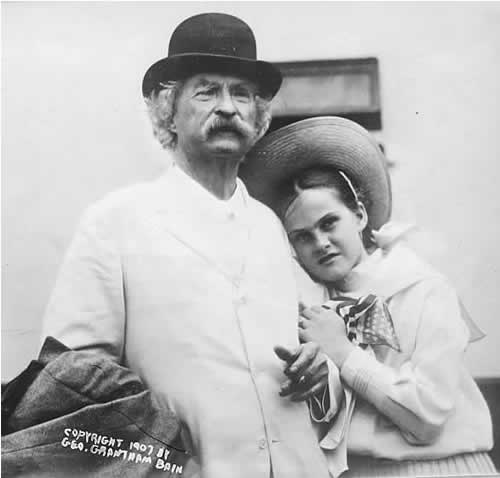
Clemens and Dorothy Quick aboard the Minnetonka, July 1907
from Library of Congress Prints and Photographs Division.
Samuel Clemens met Dorothy Quick aboard the S.S. Minnetonka, in July 1907. He was returning home to America after receiving an honorary degree from Oxford University in England. Among the 129 passengers who made the trip on board the Minnetonka, Clemens was the most famous and instantly recognizable. Dorothy Quick was traveling with her mother Emma Gertrude Quick and her grandparents Charles E. Aaron and his wife Elizabeth Aaron of New York and Plainfield, New Jersey. Dorothy's father Henry Stanhope Quick was the son of Henry S. Quick--a shipmaster and commodore for the Southern Pacific Steamship line. Dorothy's father was not a part of her life at the time Clemens met her. Charles Aaron served the role of a father figure for his young granddaughter. Aaron was president of New York Leather Belting Company, a large leather manufacturing establishment in New York. For the duration of the trip from July 12 - 22 Clemens and Dorothy Quirk were constant companions.
Dorothy Quick later described her attraction to the world famous celebrity:
I was a very intense child, strong in my likes and dislikes. Loving few outside of my family, I had given my heart to Mr. Clemens in a combination of hero worship and the deep affection that it is only possible for a child to hold (Quick, p. 36).
When the Minnetonka docked in New York, Clemens was surrounded by reporters and news reports the following day included stories of his friendship with young Dorothy Quick.
Clemens's relationship with Dorothy Quick grew via cards, letters, and personal visits. Quick became one of his most faithful and prolific correspondents and when he later instituted his Aquarium Club, she was among its first members. Dorothy stayed with Clemens at his Tuxedo Park home from August 5 - 9. A few hours after her visit Clemens wrote her a letter:
I went to bed as soon as you departed, there being nothing to live for after that, & the sunshine all gone. How do you suppose I am going to get along without you? For five hours this has been a dreary place, a sober & solemn place, a hushed & brooding & lifeless place, for the blessed Spirit of Youth has gone out of it, & left nothing that's worth while. Aren't you sorry for me, you fresh breeze blown from fragrant fields of flowers? I thought this was a home. It was a superstition. What is a home without a child? particularly a home that's had such a child as you in it. It isn't a home at all, it's merely a wreck (Cooley, p. 49).
For her birthday on September 1 Clemens sent a telegram offering to send her elephants and monkeys. When Dorothy replied she would rather have his books, he sent them and later gave her a tiny white elephant. It was a gift that would lead to her lifelong interest in collecting elephant statuettes which would number over 1,000 by the time she died.
Dorothy's previous education had been at the hands of a governess. In the Fall she enrolled in Plainfield (New Jersey) Academy which was about thirty miles away from New York and close enough to allow train visits on weekends. Dorothy visited Clemens a few days after her birthday from September 3 - 12, 1907. On October 5, 1907 Clemens recalled Dorothy's recent visit to his home:
She is just eleven years old, and seems to be made of watch-springs and happiness. The child was never still a moment, when she wasn't asleep, and she lit up this place like the sun. It was a tremendous week, and an uninterruptedly joyful one for us all. After she was gone, and silence and solitude had resumed their sway, we felt as if we had been through a storm in heaven (Cooley, p. 73).
Most of the existing photos of Clemens with Dorothy Quick were taken during her visits with him at Tuxedo Park. In the fall Clemens moved to his home at 21 Fifth Avenue in New York and Dorothy visited him again shortly before Christmas. Dorothy convinced him to attend a dinner in his honor at the Pleiades Club -- a dinner that her mother had helped arrange. For Christmas Dorothy presented him with a gift of a pocket knife -- renewing the Christmas tradition of gift giving that he had foregone during the last few years.
Their correspondence continued with his letters often containing cartoon drawing of cats and bugs designed to delight a child's eye. Quick again visited with Clemens at the Fifth Avenue home in April and May 1908.
On April 17, 1908 Clemens again dictated his thoughts about Dorothy Quick:
What a Dorothy it is! How many chapters have I already talked about her bright and booming and electrical ways, and her punctuationless literature and her adorably lawless spelling? Have I exhausted her as a text for talk? No. Nobody could do it. At least nobody who worships her as I worship her (Cooley, p. 138).
When Clemens moved to his home in Redding, Connecticut Dorothy visited in July and again in September 1908. Throughout her visits, Clemens entertained her with card games, billiard games, trips to the theatre, charades, and reading. Clemens took great delight in Dorothy's interest in becoming an author and he tutored her in the art of how to become a great writer.
As Clemens health deteriorated he began taking trips to Bermuda for the beneficial effects of the mild Bermuda climate. His correspondence with Dorothy was less frequent and less playful. There were no recorded visits between the two in 1909. In March 1910 Dorothy's mother accompanied her to Bermuda to visit Clemens who had returned there after the death of his daughter Jean. While there Clemens introduced them to future president Woodrow Wilson. Dorothy's trip was cut short when her mother received word that her brother (Dorothy's uncle) Charles Aaron of Plainfield, New Jersey had died unexpectedly. The time spent with Clemens in Bermuda in March 1910 was their last visit. Dorothy and her mother were in Europe when they received news that Clemens had died in April.
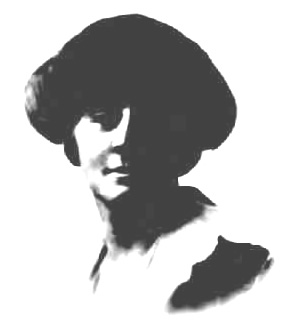
Mrs. Emma Gertrude
Quick, a young mother who shared a close physical resemblance to her daughter
Dorothy Quick,
from her passport photo of 1919.
In 1919 Dorothy's mother Emma Gertrude married Thomas Jefferson Mumford, a wealthy widower from Plainfield, New Jersey. Mumford, a stock broker and a member of Fahnestock and Company banking firm was thirty years older than Emma. Shortly after the marriage, the elderly Mumford suffered a complete collapse of health and his young wife managed his financial affairs. Emma transferred over 20,000 shares of railroad and oil stocks valued at over $3,000,000 from Mumford's estate to herself. Prior to Mumford's death in 1924 she established a trust fund for Dorothy. Executors of Mumford's estate later initiated a lawsuit to recover the money due the estate from Emma and Dorothy. The lawsuit was unsuccessful.
In November 1925 Dorothy Quick married John Adams Mayer. Mayer had received his education at the University of Pennsylvania and the United States Naval Academy. During World War I he had served as an officer aboard the cruiser South Dakota and later as executive officer on the destroyer ship Hopkins. At her wedding, Dorothy was given away by attorney George Murray Brooks who had successfully represented her mother in the lawsuit with executors of the Mumford estate.
Dorothy Quick continued to pursue a writing career. The social pages and society news of The New York Times were filled with activities she and her mother participated in throughout the 1920s and 1930s. Gertrude Mumford became a member of the board of trustees of the Manhattan School of Music and chairman of the women's committee of the New York Opera Comique. Dorothy wrote plays, novels, poetry, gave radio lectures, and sometimes gave newspaper interviews related to her friendship with Mark Twain. Dorothy's father Henry S. Quick died in May 1935. Dorothy's husband John Adams Mayer, who had been employed as an advertising executive, died unexpectedly on March 15, 1940. Dorothy's mother died two years later on April 17, 1942.
Dorothy Quick continued to write novels and poems published under her maiden name until her death March 15, 1962. Her obituary appeared in The New York Times and her friendship with Mark Twain was prominently recalled. Her memoir Enchantment: A Little Girl's Friendship with Mark Twain was first published in 1961--just a year prior to her death and later reprinted under the title Mark Twain and Me. The book was later made into a movie for television in 1991 starring Jason Robards as Mark Twain. Correspondence between Dorothy Quick and Clemens was published by John Cooley in Mark Twain's Aquarium: The Samuel Clemens Angelfish Correspondence, 1905-1910.
_____
MARY BENJAMIN ROGERS
December 1, 1878 - September 21, 1956
Mary Benjamin Rogers was the daughter-in-law of Clemens's close friend and financial advisor Henry Huttleston Rogers--a Standard Oil multimillionaire. In 1897 Clemens had dedicated his book Following the Equator to Henry's young son Henry Rogers II, who was called Harry. In 1900, when Harry was a junior at Columbia College in New York, he married Mary Benjamin. Clemens sent Mary a letter wishing the couple "a long and happy life and great prosperity" (Mark Twain's Letters to Mary, p. 14).
Mary Benjamin was not a stranger to the Rogers family. She was the daughter of George Hillard Benjamin and the niece of William Evarts Benjamin who was married to Henry H. Rogers's daughter Anne. William Evarts Benjamin, a bookseller and publisher, had helped Clemens during his financial strife by purchasing in the 1890s the rights to Clemens's Library of American Literature underfunded publishing venture. Mary's grandfather was Park Benjamin, a leading poet and New York journalist who had been associated with Horace Greeley in establishing the New York Tribune and with Henry J. Raymond who founded The New York Times. Mary's father George Hillard Benjamin was internationally known as a patent expert and industrial engineer. He had been a practicing physician and was noted as a criminologist who frequently contributed his skills to solving crimes with his expertise in chemistry. In addition, he had been licensed to practice law in 1884 and assisted in organizing many large corporations including Western Electric. At the time of his death, Mary's father had acquired eighteen academic degrees. Mary's mother was Jane Seymour of Ogdensburg, New York.
Mary and Harry Rogers spent a year abroad after their marriage. In 1902 their daughter Mary Millicent Rogers was born. In 1905 their son Henry Rogers III was born. Clemens's close friendship with Henry H. Rogers brought him into increasing contact with Mary and Harry and their young family. Clemens began to think of Mary as a surrogate niece and often signed his correspondence to her as a loving uncle. Few letters from Mary to Clemens survive but those that do show she was a talented wordsmith and Clemens took great delight in corresponding with her. He often sent her portions of his autobiography to read and comment on and pleaded with her to send him "butter"--his code name for compliments. He admired Mary's youth and vitality which were characteristics she shared with a number of the young women he later designated member of his Aquarium Club. On August 14, 1906 he wrote:
Ho, you miraculous combination of quicksilver, watchsprings and sunshine, how you do dance out from your pen and light up this solemn solitude and set things amoving! No matter how long you live you'll never get old, (thanks be!) My wife never did, neither did my mother; and my mother lived to be 88, and always she was all animation and champagne and charm, like you (Mark Twain's Letters to Mary, p. 42).
When Clemens moved into his new home at Redding, Connecticut in June 1908. Harry and Mary Rogers were among his first visitors. Mary presented him with a guest book which quickly filled with names of visitors.
Henry H. Rogers died in 1909, Harry inherited much of his father's wealth. Harry's interests were in a military career rather than industry. He studied field artillery in Europe in 1910. In 1913 he graduated from the School of Fire, United States Army at Fort Sill, Oklahoma and served on the border of Mexico in 1916. He eventually advanced to the rank of colonel. He served with the American Expeditionary Forces in World War I commanding the Third Field Artillery. For his war service he received numerous citations for exceptionally meritorious services. Mary was an active volunteer for the Red Cross during the war.
In 1929 Mary Benjamin Rogers obtained a divorce from her husband in Utrecht, Holland. Newspaper reports later hinted Mary had received a settlement of $3,000,000 and that another woman was responsible for the breakup of the marriage. Harry later remarried twice prior to his death in July 1935. By the terms of his will, his son Henry Rogers III received only the income from a $500,000 trust. The bulk of Harry's estate of $15,000,000 went to his third wife, his daughter Millicent and her son. Newspapers reported that Harry was displeased with his son Henry Rogers III when he sided with his mother at the time of Mary's divorce and that was the reason he did not receive a larger share of his father's estate.
Mary and Harry's son Henry Rogers III married in 1929 and tried to make a name for himself in the entertainment industry. In September 1935 his name was linked with the death of singer and actress Evelyn Hoey who died by a gunshot wound to her head while a guest in his home near Downington, Pennsylvania. Hoey's death was later ruled a suicide. Henry Rogers III died in Hollywood June 20, 1948. Among the mourners at his funeral was Mrs. Eugene Ford Seymour, Mary's aunt by marriage and the mother-in-law of actor Henry Fonda.
Mary's daughter Millicent died on January 1, 1953 in New Mexico. She had been in the society columns of newspapers as they followed her three marriages and three divorces. In her later years she settled into the quiet existence of an artist and purchased a small ranch near Taos, New Mexico.
Mary Benjamin Rogers who had outlived both her son and daughter died September 21, 1956. She had spent her latter years as an artist with an interest in Navajo Indian art. She was survived by three grandsons and two great-grandchildren. She donated her letters from Mark Twain to Columbia University in New York in 1953. A number of the letters were published in a small volume by Columbia University Press and edited by Lewis Leary titled Mark Twain's Letters to Mary.
_____
ETHEL DONALDSON SLOAN
August 25, 1886 - January 1978
Clemens's acquaintance with Ethel Donaldson Sloan was unknown to most Mark Twain scholars until a collection of items from her estate appeared on an Ebay auction in April 2007. Clemens met Sloan in January 1910, on his last trip to Bermuda and a few months prior to his death. Among the items from Sloan's collection was an autographed copy of Eve's Diary dated Bermuda, January 31, 1910; photos; a two-page manuscript of a Valentine poem dated February 14, 1910; and a handwritten maxim dated January 15, 1910.
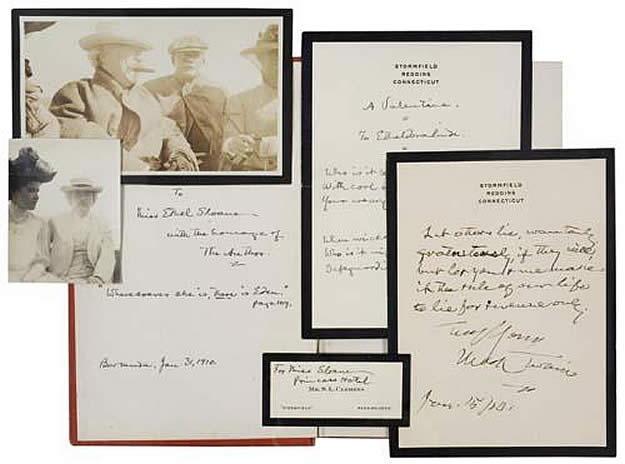
One the back of one photo was an inscription from Marion Schuyler Allen, mother of angel-fish Helen Allen, which read:
For the dear man's "Doralinda" this picture taken the last day he was able to dress From Marion Schuyler Allen
The maxim written on Stormfield letterhead and dated January 15, stated, "Let
others lie, wantonly, gratuitously, if they will, but let you & me make
it the rule of our life to lie for revenue only."
Clemens penned a two page valentine for Sloan on Stormfield letterhead.
|
STORMFIELD A Valentine. To Etheldoralinda Who is it soothes your aching head Aunt Lizzie When wicked Satan lays for you, Aunt Lizzie Who stands as firm as Mary's lamb Aunt Lizzie Who all your life will wish you well Aunt Lizzie Bermuda, 14th February, / 10 |
Ethel Donaldson Sloan was the daughter of Robert Sage Sloan and his wife Ethel Donaldson of Woodmere, Long Island, New York. Robert Sage Sloan was a graduate of the Annapolis Naval Academy. Sage retired from the navy in 1898. Ethel's grandfather was George Beale Sloan, a wealthy Oswego, New York businessman and former New York state senator. One of Ethel's maternal great grandfathers was Colonel Timothy Pickering, the first secretary of state in President George Washington's cabinet.
In July 1911 Ethel Donaldson Sloan married Captain John Sinclair Liddell of the British Army. The couple returned to Bermuda where Liddell was stationed with his regiment. When Liddell's regiment was transferred to South Africa, the couple made their home in that country. Prior to his death, Liddell reached the rank of Lieutenant Colonel. After her husband's death Ethel remained in England and later remarried to Major Ernest George MacDonald Porcelli in 1926.
Clemens met Sloan only a few months prior to his death. The short manuscripts he wrote for her are among some of his last known works. No correspondence between Clemens and the Sloan family has been found.
_____
JEAN WOODWARD SPURR
March 13, 1895 - May 1979
Clemens dictated a portion of his autobiography on April 17, 1908 and spoke of angel-fish Jean Spurr, "such is the kingdom of heaven" (Cooley, p. 140.) Spurr was one of the angel-fish Clemens met in Bermuda in March 1908. According to his secretary Isabel Lyon, Jean wore a blonde wig and had no eyebrows or lashes but that defect did not prevent Clemens from admiring her. Lyon wrote, "He sees into her fair young soul" (Hoffmann, p. 188). On March 23 Clemens went on a picnic with Jean Spurr and another angel-fish Hellen Martin. He wrote his daughter Clara, "We are having good times. To-day I went pic-nicking with some other children, & romped in the sand on the sea-shore about 6 hours (Hoffmann, p. 119).
Jean Spurr was the daughter of Edwin Robert Spurr and his wife Harriet of 129 Mt. Pleasant in Newark, New Jersey. Spurr was a cut stone contractor whose father Joseph J. Spurr had established the Spurr Stone Company. The family's stoneworks were located on the Passaic River and the enterprise furnished stone for some of the most impressive buildings in New York City.
When Jean Spurr returned to New York from Bermuda, newspaper reporters were eager to get reports on Mark Twain's activities on the island. Young Jean found her name in the national news in an article that was copied by newspapers across the country
|
NEW YORK DAILY TRIBUNE, March 27, 1908, p. 6. MARK TWAIN ON BEING NAUGHTY. Although there is more than seven hundred miles of blue sea between New York and Mark Twain, this port is receiving prolific reports of his doings at Bermuda. According to hundreds of travellers who have arrived here since Mark Twain too H. H. Rogers to the island, the humorist is the most popular man at Bermuda. The number of puffs he bestows upon a cigar and the billiard scores he runs up on Mr. Rogers are recorded in notebooks of persons who "follow the man from Cook's." The steamship Bermudian arrived yesterday with many passengers and more stories of the humorist and the financier. Miss Jean Spurr, a twelve-year-old girl of Newark, showed the programme of a ball she attended. Miss Spurr had told Mr. Clemens that there were many "old maids" present, and he wrote: "Considering the proportion of things, it is better to be a June bug than an old bird of Paradise." On the programme of another girl who had a habit of making grimaces at persons she disliked the humorist wrote: "Never do anything naughty when any one is looking." |
No letters from Clemens to Jean Spurr have been recovered. One letter from Spurr to Clemens dated April 9, 1908 is in the Mark Twain Papers at the University of California at Berkeley. In October 1919 Spurr married Walter W. Gamble of Newark, New Jersey.
_____
DOROTHY MARGARET STURGIS
July 28, 1891 - January 1978
Samuel Clemens encountered the Sturgis family at the Princess Hotel in Bermuda during his 1908 spring trip to the island with his friend Standard Oil executive Henry H. Rogers. Richard Clipson Sturgis and his son Richard, Jr. were Boston architects. Mrs. Sturgis was the former Esther Mary Ogden and sixteen-year-old daughter Dorothy was a student at Winsor School in Boston. Richard Sturgis had served as school house commissioner for the city of Boston and would later become president of the Boston Society of Architects. Sturgis had known Clemens for a number of years from the Tavern Club in Boston. In addition, Sturgis was a friend of architect John Mead Howells, son of Clemens's friend William Dean Howells. One of Dorothy's favorite books was The Prince and the Pauper and she was delighted to make the acquaintance of one of her favorite authors. Clemens soon awarded Dorothy with an angel-fish pin--"a tiny, enamelled pin in the form and colors of the local marine beauty" (Harding, p. 4).
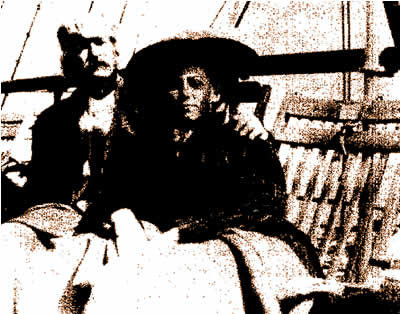
Clemens and
Dorothy Sturgis, 1908.
In a memoir written in 1966, Dorothy Sturgis related that the family had been in Bermuda on a holiday while her mother Esther recovered from an operation. The Bermuda trip was a gift from her well-to-do cousin Henry Sturgis Grew whose daughter Jessie Grew had married Jack Morgan, son of wealthy financier J. Pierpont Morgan. According to Dorothy, she had never thought of her family as struggling financially and it was only in comparison to wealthier branches of the family that this seemed to be the case.
Clemens, Rogers and the Sturgis family returned to New York together on April 13, 1908 aboard the S.S. Bermudian. Clemens and Dorothy Sturgis were close shipboard companions. When the ship encountered a storm and rough sailing, both Clemens and Dorothy Sturgis who had been strolling on deck together had been knocked down by a wave that had crashed overboard but were uninjured. Newspapers around the country were eager to report the incident when the ship docked in New York. Sturgis wrote:
He, I think, got a scolding for taking such chances with his precious person, but Mama was well used to my being her despair for my reckless ways with wind, water and horses, and I recollect no undue reprimand (Harding, p. 6).
Clemens and Dorothy Sturgis began a brisk correspondence in the following weeks. Sturgis, a student at Winsor School in Boston, had a talent for art and a desire to be an artist along with an appreciation for literature. Sturgis's parents allowed her to accept an invitation to visit Clemens at Stormfield in Redding, Connecticut in September 1908 in the company of her governess. She arrived at Stormfield on the evening of September 18, 1908--less than twenty-four hours after the house had been burglarized. Sturgis helped Clemens compose an illustrated placard titled "Notice. To the Next Burglar" which was posted on the door of Stormfield -- the text of which was published in newspapers across the country.
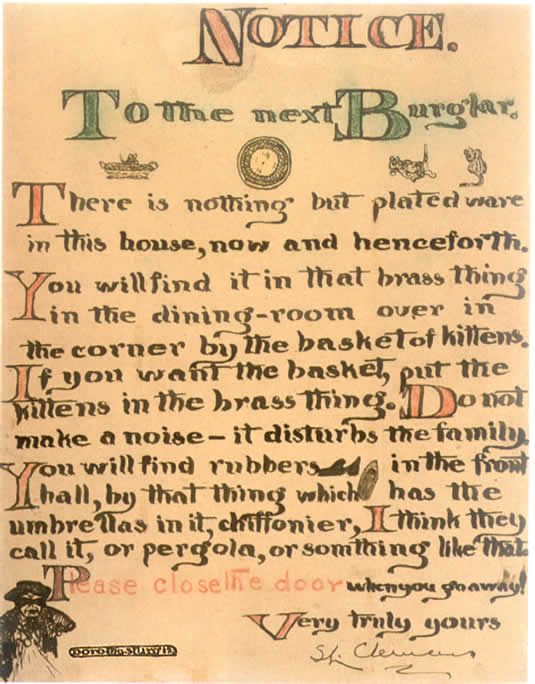
Notice illustrated
by Dorothy Sturgis and Clemens.
In January 1909 Clemens wrote Sturgis that the "Notice" would appear in the magazine Country Life. According to Sturgis, the admiration of the burglar placard helped to firmly fix her ambition to become an artist.
At age sixteen, Sturgis's correspondence reveals a maturity and intellect that is lacking in other members of Clemens's younger Aquarium Club members. Sturgis enjoyed playing billiards with Clemens and playing music on his Aeolian orchestrelle.
Daytimes we used to sit, autumn sunshine permitting, out on the loggia, probably while he was reading his mail, and talk about current affairs. Always interested in politics, he gave me, I remember, a dissertation on Teddy Roosevelt's views after assuming the Presidency at the death of McKinley. In 1908 T. R. strongly favored Howard Taft and made no bones about saying so. Mr. Clemens remarked that, when it came to the point of a President of this country designating his successor, it looked to him as if we would no longer be a Republic but were headed for some kind of monarchy. Then there were the walks, often to a beautiful little point in the woods nearby. Here we sat on a rock and read aloud to each other, especially Kipling, and we agreed that our favorite story was "The Brushwood Boy." From then on we called each other the "Major" and "Annie-an-Louise," as the subsequent letters testify (Harding, pp. 8-9).
Clemens also took Dorothy Sturgis into New York to see Billie Burke in a play, a four-act comedy called "Love Watches," and then backstage for a visit with the stars.
After Sturgis's visit, Clemens wrote to her on September 30, 1908:
You dear delightful Annieanlouise! You cannot realize how much we all miss you, nor what a contenting charm your presence was, nor how it pervaded this house like a fragrance, & refreshed its mouldy and antique atmosphere with "the unbought grace of youth." I wish you were back again (Cooley, p. 211).
Dorothy Sturgis attended the Boston Museum of Fine Arts in 1910. She later studied art under Frederick G. Hall of Harvard and with Elizabeth Shippen Green Elliott, a well-known illustrator. In June 1912 she married Lester William Harding. The couple eventually had three children. Dorothy pursued a successful career as a black and white artist specializing in book plates. She designed book plates for a number of notables including Eleanor Roosevelt and Norman Rockwell. Dorothy and her family relocated to a farm home on Little Harbor Road in Portsmouth, New Hampshire where Dorothy contributed to her share of farm work by helping deliver milk, eggs and vegetables to farm customers.
When the United States entered World War II, Dorothy Sturgis Harding devoted her artistic talents to the war effort as a draftsman for the Portsmouth Navy Yard making drawings of submarines. She was profiled in the local Portsmouth Herald on May 14, 1943 under the headline "Portsmouth Grandma Does Part in War Effort." Dorothy completed a 15-week course in engineering drafting at the University of New Hampshire to support her new career in technical drawing. Regarding the war, Dorothy explained, "This is a woman's war too and we've got to fight it."
In November 1966 Columbia Library in New York reported it had acquired Mark Twain's letters to Dorothy Sturgis with the assistance of Henry Rogers Benjamin, grandson of Clemens's friend Henry Huttleston Rogers. A number of these letters were published by John Cooley in Mark Twain's Aquarium: The Samuel Clemens Angelfish Correspondence, 1905-1910. A number of Dorothy's letters to Clemens are in the Mark Twain Papers at the University of California at Berkeley.
Dorothy Sturgis Harding died in January 1978. In January 2008, one of her descendants appeared on the PBS show "Antiques Roadshow" exhibiting an angel-fish pin from Mark Twain. The pin did not match any known description of the official club badge and appeared to be designed for an older woman rather than a young girl.
_____
CHARLOTTE TELLER
March 3, 1876 - December 30, 1953
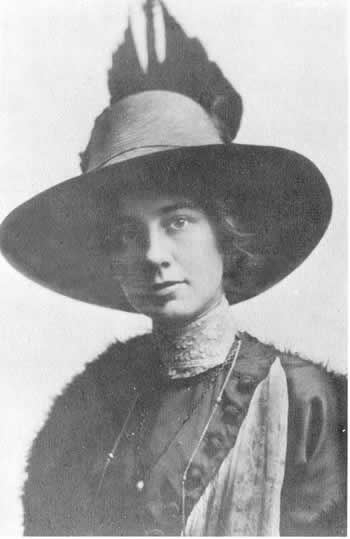
Charlotte Teller,
Mark Twain's neighbor on Fifth Avenue.
Photo courtesy of Southern Historical Collection, Wilson Library, The University
of North Carolina at Chapel Hill.
Samuel Clemens first met Charlotte Teller on March 27, 1906. Teller was, an attractive thirty-year-old writer who lived at 3 Fifth Avenue, not far from Clemens's 21 Fifth Avenue home. Teller was involved with a socialist movement in New York and made arrangements for Clemens to meet the Russian revolutionary Nikolai Tchaykovsky and participate in activities for an upcoming visit from Russian writer Maxim Gorky. She invited Clemens to lend his support to the Russian revolutionary movement. (For a full account of this story see "Mark Twain on Czars, Siberia and the Russian Revolution.") Teller, who was once married to Washington, D.C. civil engineer, Frank Minitree Johnson, introduced herself to Clemens and his secretary Isabel Lyon as Mrs. Johnson. Isabel Lyon recorded in her personal journal:
A young and delightfulish Mrs. Johnson came in yesterday to ask if Mr. Clemens would care to meet Mr. Tschaykoffski, the Russian Revolutionary agitator. He came and Mr. Clemens had a good talk with him, but discouraged him a bit I fear. Mrs. Johnson herself is a clever creature, I believe, for she attracts you and she told me how for a year she has been working on a Joan of Arc play for Maude Adams (Hirst, Mark Twain Forum archives, 29 Nov 2000).
Teller was the niece of United States Senator from Colorado Henry Moore Teller who had served as Secretary of Interior under President Chester Arthur. Her father was Colorado attorney James Harvey Teller. Her mother was Francis Leonora Wheelock, a direct descendant of the first president of Dartmouth College. Charlotte graduated from the University of Chicago in 1899. After 1900 Charlotte's short stories and news features were appearing in various newspapers and journals including Everybody's Magazine, Wilshire's Magazine, Harper's Weekly, and Metropolitan magazine. Teller had married Frank Minitree Johnson on September 4, 1902 but by the time she met Clemens, she was living with her grandmother at 3 Fifth Avenue, a cooperative apartment house known as the "A Club," with a group of other writers. The date of Teller's formal divorce from Johnson remains unverified. At the time she met Clemens she was a writer struggling with her finances as she tried to sell her plays and get her first book published -- a romance set at the time of the Chicago Haymarket riots titled The Cage.
Teller was bright, articulate, attractive, and a struggling writer. She lived within easy walking distance of Clemens and she provided him company and a release from loneliness. They spent time together discussing her Joan of Arc play and how Maude Adams should play the lead. They discussed her play about the French statesmen Mirabeau, and her other writing projects. Clemens loaned Teller a copy of Carlyle's French Revolution and other books from his personal library for Teller to use as reference material for her play on Mirabeau. When Maude Adams was unable to pay for an option on Teller's play about Joan of Arc, Clemens loaned Teller money. In a letter to his friend and financial advisor Henry H. Rogers dated April 9, 1906, Clemens requested that Rogers withdraw $1000 in various denominations of bills from Clemens's account at Guaranty trust. Clemens added "Miss Lyon doesn't know about this" (Mark Twain's Correspondence with Henry Huttleston Rogers, p. 605). The hint to Rogers was that the withdrawal should remain confidential.
Clemens came to think of Teller as a protégé and wrote to her on April 13, 1906, "there is greatness in you Charlotte, - more of it than you suspect, I think. You are going to surpass your utmost anticipations" (S.L.C. to C.T., p. 9). When Clemens went to Dublin, New Hampshire for the summer at the end of May, the two remained in contact via telephone and correspondence. Teller would mail manuscripts to Clemens who would provide comments and suggestions. In the fall of 1906 Clemens provided Teller with an advertising endorsement for her book The Cage which was in the form of a personal letter to Maude Adams applauding Teller's novel. He also provided Teller with a calling card of introduction to theater impresario Charles Frohman who he hoped would take an interest in producing Teller's works on stage.
In October 1906 Clemens's secretary Isabel Lyon, perhaps jealous of his association with Teller, told him of rumors circulating regarding himself and Teller. When Clemens asked Teller to find another residence out of the neighborhood where he could continue to visit with her, she refused. Indignant that Clemens might believe the rumors that she was a fortune hunter and determined to succeed without his help, Teller returned to Clemens his letter to Maude Adams endorsing The Cage as well as Clemens's calling card to Charles Frohman. That same day Clemens wrote to the wife of Henry Rogers, "There's been heart-burn enough to almost move me to take out a fire-policy. Indeed, to use Uncle Henry's phrase, I've had a hll [sic] of a week." (Mark Twain's Correspondence with Henry Huttleston Rogers, p. 618).
Teller's book The Cage was published in March 1907 and received mixed reviews. The original manuscript which contained Clemens's written marginal comments has not been recovered. On May 20, 1907 Teller wrote asking to meet with Clemens again in regard to rumors that continued to circulate about their relationship. Clemens sent Isabel Lyon to meet with Teller who was still indignant over marriage rumors and that she was adventurer who was planning a wedding to Clemens. While Clemens was in England to receive an honorary degree from Oxford, the following article containing the marriage rumor appeared in a California newspaper headlined "Mark Twain and Charlotte Teller."
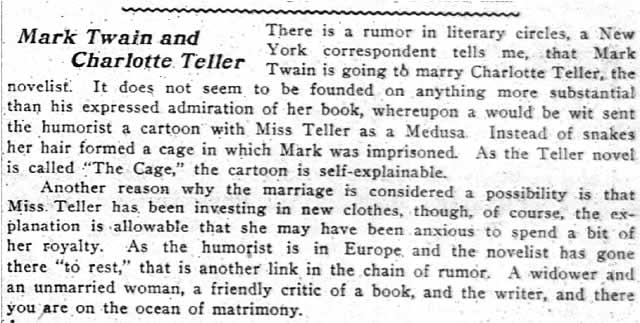
SAN FRANCISCO
CALL, July 2, 1907, p. 8.
Two days later the Washington Post and other newspaper ran marriage rumor stories -- this time stating Clemens was to marry his secretary Isabel Lyon. The following day, on July 5, Clemens gave the following statement which appeared in various newspapers, "I have not known, and shall never know, any one who could fill the place of the wife I have lost. I shall never marry again (Hill, p 173).
On August 20, 1907 Teller returned to Clemens $150 she had borrowed when Maude Adams had delayed paying for a second half of an option on her Joan of Arc play. Teller reported that Maude had just made the payment. "I have been deeply mortified not to be in a position to repay you before," she wrote. Teller again wrote Clemens on February 15, 1908 asking to meet with him. There is no evidence he responded or met with her. However, their correspondence did continue. Teller was abroad trying to sell her play "Mirabeau" when Clemens's friend and financial advisor Henry H. Rogers died in May 1909. Teller sent Clemens a note of condolence. In July 1909 Clemens, from his home at Stormfield, replied to Teller indicating he would like to see her in New York when cooler weather came. Clemens had fired his secretary Isabel Lyon in mid-April 1909 and Teller felt that his desire to see her again indicated that he realized Lyon had been behind the breakup of their friendship. Teller later recalled her thoughts when she read the news of Clemens's death:
He said at one time that when he did die, he would send me a message. He put it this way. "When I am dying Charlotte, I will send you a message. No one in the world will know that I am sending it, but you will know when you receive it."
The morning I read of his death, I though of that message, and as I read in the newspaper accounts, I found that he had asked for the copy of the French Revolution which I had at one time used in my play and opened to a certain page (Mr. Paine also speaks of this in his "Biography") and that what he had been reading was a portion that he and I had often discussed. This may have been mere coincidence, but I have never felt it so, because he was a man of great loyalty to his friends, and very sensitive, and I believe he felt that he had been unkind in taking Miss Lyons' word. (S.L.C. to C.T. , p. 6-7).
Charlotte Teller's writing career continued with financial support by Mary Haskell, a headmistress of a Boston school who also was supporting artist and writer Kahlil Gibran at the same time. Haskell contributed approximately $12,000 to Teller's living expenses over the course of several years. In April 1911 Teller accepted an offer from Walter Hampden to travel with a repertory group called The Lyceum Players playing the role of Lady Parchester in The Walls of Jericho. (Walter Hampden later played the role of Jervis Langdon in the movie Adventures of Mark Twain.) After a few weeks she became disillusioned with acting and returned to New York where she continued to write and sometimes gave lectures on the topic of the French orator Mirabeau.
On October 14, 1912 Charlotte Teller married for the second time to Gilbert Julius Hirsch, a young Columbia law school graduate who was eleven years younger than she. The couple spent a year and a half in England, Germany and France. Their son Richard Teller Hirsch was born in Germany in 1914. The family returned to the United States shortly after the outbreak of World War I. In July 1915 the couple traveled to Berlin where Gilbert Hirsch worked as a correspondent of the New York Evening Post. Shortly before the couple left, the federal Bureau of Investigation had been investigating Charlotte Teller Hirsch as being involved with delivering a bribe from the Germans to Samuel Gompers, head of the American labor union, to keep workers on strike and not producing war armaments. No evidence surfaced to support the bribe allegations.
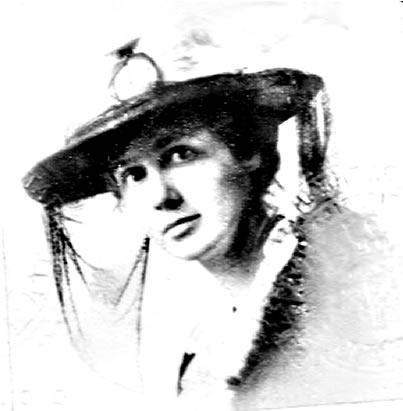
Charlotte Teller
Hirsch, passport photo from July 1915.
The Hirsch family returned to the United States in 1916 where Gilbert worked at the Library of Congress as a research assistant translating foreign laws. He eventually advanced to become chief of the Legislative Reference Division of the Library of Congress. Gilbert Hirsch resigned his position with the Library of Congress and the family moved to France where he worked for a short time with the U.S. Tariff Commission until 1923. There is no evidence Hirsch was regularly employed after his departure from the U. S. Tariff Commission. The family remained in Paris and struggled financially.
In 1925 Charlotte Teller's collection of letters from Clemens were privately published with an introduction from Teller indicating her desire that the letters be kept intact. Teller most likely sold the letters to a private dealer for publication in order to obtain money for living expenses. The letters are now in the Berg Collection of the New York Public Library.
On May 3, 1926 Gilbert Julius Hirsch killed himself by jumping out of their third floor window-- it was his second attempt of that week. He had survived a first jump. Charlotte Teller Hirsch and her son remained in Paris where she led the life of a struggling writer supported by family and friends. In 1934 she moved to Versailles. She died there on December 30, 1953. She was survived by her son Richard and three grandsons. The location of her original manuscript of The Cage with Clemens's notations is unknown.
_____
CARLOTTA WELLES
April 28, 1889 - April 1979
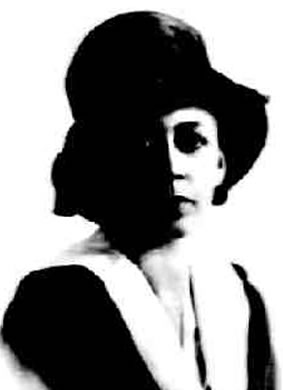
Carlotta Welles,
from her passport photo.
On June 8, 1907 Clemens sailed to England aboard the S. S. Minneapolis to accept an honorary degree from Oxford University. On board the Minneapolis was eighteen-year-old Carlotta Welles. Carlotta's features reminded Clemens of his dead daughter Susy and he soon initiated a friendship with her. He nicknamed her "Charlie" and wrote notes to her encouraging her to come out of her room and visit with him on deck:
Charlie Dear, You don't know what you are missing. There's more than two thousand porpoises in sight, and eleven whales, and sixty icebergs, and both Dippers, and seven rainbows, and all the battleships of all the navies, and me (Cooley, p. 40).
Clemens sent Welles an autographed copy of one of his books, an autographed photo and a cartoonist on board the ship drew a caricature of them together. Welles, however, remained largely indifferent to Clemens's attentions. She would later recall, "I used to get restless and chafed at times at being expected to sit quietly with him when my inclination was to race around" (Cooley, p. 35).
Carlotta Welles was the daughter of Francis Raymond Welles and his wife Anna Francis Thomas. Francis Welles's ancestors could be traced back to Connecticut in 1635 and included one governor of the Connecticut Colony. Francis Welles's father had been a manufacturer of agricultural implements. Anna Thomas's father had been a Presbyterian minister. Francis Welles graduated from the University of Rochester in New York in 1875 and the following year had been employed in the Chicago office of the Western Electric Company. In 1880 he was sent to Australia and New Zealand to introduce the Bell telephone to those countries. In 1882 he traveled to Belgium to establish the first foreign branch of Western Electric Company and thereafter made his home in Europe. He established Bell Telephone factories in Antwerp, Paris, London, Berlin and Milan.
Carlotta Welles was born in Alassio, Italy. Her father named her Charlotte, but Italian officials translated it to Carlotta and the name remained. Carlotta and her family traveled extensively between Europe and the United States. Carlotta's parents were members of the Presbyterian American Church in Paris. Her father was an avid reader and book collector with interests in politics, economics and astronomy. Carlotta was an avid bird watcher who loved the outdoors.
Clemens's known correspondence with Carlotta Welles consists of eight letters to her, several of which were written aboard the Minneapolis. Seven notes and letters from Carlotta Welles to Clemens are in the Mark Twain Papers at the University of California at Berkeley. On May 29, 1908 Clemens wrote a letter of apology to Welles for her not being admitted to his home at 21 Fifth Avenue in New York when she had stopped by unexpectedly.
Dear Charley, I am vexed to the last limit, & disappointed, & so sorry. If my secretary hadn't chanced to be out, it would not have happened, for she sees all strangers that come, whereas I see none of them. The butler took you for a stranger, & followed the law of the house, but if you had told him you were a friend he would have found me, for I was in my room. In fact he did fine me, but I was asleep, & so he foolishly & criminally did not wake me. I hope you will not come as a stranger next time, & I also hope that there will be a next time (Cooley, 163).
Welles later recalled she had been on her way to see her sister graduate from Bryn Mawr when she stopped by Clemens's home and was refused admittance. Although she sent him two subsequent letters, there is no record he ever responded.
During World War I Carlotta Welles worked in the anti-typhoid vaccine laboratories of the Val-de-Grace Military Hospital the winter of 1914-15. She became a member of the Shurtleff Memorial Relief, an organization that supplied clothing, food, and furniture to war refugees. Her family opened the Welles home at Bourré, Loir et Cher, to the French Government as a convalescent hospital for the wounded. When America entered the war the Welles home was offered to the American Expeditionary Force as Headquarters for that area. Mr. and Mrs. Welles spent two winters there attending to the needs of the officers housed with them and to the American soldiers stationed nearby.
One of Carlotta's close friends in Paris was Sylvia Beach whose father was also a Presbyterian minister. Sylvia Beach later gained fame as the proprietor of the Shakespeare and Company book shop which published James Joyce's Ulysses in 1922. When Beach's business venture was near collapse, Carlotta was among those who provided financial assistance.
Carlotta Welles later married James Elmer Briggs, Jr. who had served in the
military in France during World War I. She died in April 1979. Although she
was never an angel-fish and her name was never mentioned by Clemens with that
designation, her correspondence with Clemens was published by John Cooley in
Mark Twain's Aquarium: The Samuel Clemens Angelfish Correspondence, 1905-1910.
_____
CONCLUSION
Samuel Clemens enjoyed the company of women of all ages. Many of his "angel-fish" were accompanied by their mothers or a governess when they visited him -- providing additional female companionship. His correspondence with them and the entertaining of them in his homes and abroad provided him a release from loneliness that often surrounded him after members of his own family had died or embarked on separate careers. Clemens was an author with a compulsion to write and many of his young correspondents provided him with an outlet for his playful expressions, thoughts and phrasings that would have otherwise been repressed and lost -- expressions that now remain insights into the creative mind of his genius.
_____
REFERENCES - ONLINE SOURCES:
Cochran, Joseph Wilson. Friendly Adventurers; A Chronicle of the American Church of Paris (1857-1931).
Colley, Brent. Mark Twain Stormfield Project 1908-2008 (accessed February 24, 2008)
Free access database Library of Congress Chronicling America.
"Robert Dennison Martin," Montreal, Pictorial and Biographical, S. J. Clarke Publishing Co., Winnipeg, Vancouver, Montreal, 1914.
Subscripton based historical records available through ancestry.com (containing U.S. Census records, passports, and steamship passenger manifests) and Footnote.com (containing original Federal Bureau of Investigation files).
Subscription based historical newspaper databases including ProQuest, Readex - America's Historical Newspapers, NewspaperArchive.com
REFERENCES:
Barrymore, Ethel. Memories. (Harper and Brothers, 1955).
Beach, Sylvia. Shakespeare and Company. (Harcourt, Brace and Company, 1959).
Burke, Billie. With a Feather on My Nose. (Appleton-Century-Crofts, 1949).
Burt, Christopher
Clinton. Personal email correspondence (18 December 2008).
Carson, John C. "Mark Twain's Georgia Angel-Fish Revisied," Mark Twain Journal, (Spring 1998).
Cooley, John, ed. Mark Twain's Aquarium: The Samuel Clemens Angelfish Correspondence 1905 - 1910. (University of Georgia Press, 1991).
Cooley, John. "Mark Twain's Aquarium: Editing the Samuel Clemens - Angelfish Correspondence." Mark Twain Journal, Spring, 1989 (issue mailed September 1991).
Fitch, Noel Riley. Sylvia Beach and the Lost Generation: A History of Literary Paris in the Twenties and Thirties. (Norton, 1983).
Gibran, Jean and Kahlil Gibran. Kahlil Gibran: His Life and World. (Interlink Books, 1991).
Harding, Dorothy Sturgis. "Mark Twain Lands an Angelfish," Columbia Library Columns, February, 1967, pp. 3-12.
Hill, Hamlin. God's Fool. (Harper & Row, 1973).
Hoffmann, Donald. Mark Twain in Paradise: His Voyages to Bermuda. (University of Missouri Press, 2006).
Lanier, Doris. "Mark Twain's Georgia Angel Fish," Mark Twain Journal. (Spring 1986).
Leary, Lewis, ed. Mark Twain's Correspondence with Henry Huttleston Rogers. (University of California Press, 1969).
Leary, Lewis, ed. Mark Twain's Letters to Mary. (Columbia University Press, 1961).
Moore, Louise Paine. "Mark Twain As I Knew Him," The Twainian, January-February, 1959.
Pound, Reginald and Geoffrey Harnsworth. Northcliffe. (Cassell & Company Ltd., 1959).
Quick, Dorothy. Mark Twain and Me. (University of Oklahoma Press, 1961). Previously published as Enchantment: A Little Girl's Friendship with Mark Twain.
Rasmussen, R. Kent. Critical Companion to Mark Twain, 2 volumes. (Facts of File, 2007).
Reed, Wallace P. History of Atlanta, Georgia. (D. Mason & Co. Publishers, 1889).
Rushmore, George M. The World with a Fence Around It: Tuxedo Park - The Early Days. (Pageant Press, Inc., 1957).
Scharnhorst, Gary, ed. Mark Twain: The Complete Interviews. (University of Alabama Press, 2006).
Seitz, Don C. Joseph Pulitzer: His Life and Letters. (Garden City Publishing Co., 1927).
Shelden, Michael. Mark Twain: Man in White. (Random House, 2010).
S.L.C. to C.T. (Privately printed, 1925.)
Swanberg, W. A. Pulitzer. (Charles Scribner's Sons, 1967).
Wagenknecht, Edward. Mark Twain: The Man and His Work. (University of Oklahoma Press, 1971).
